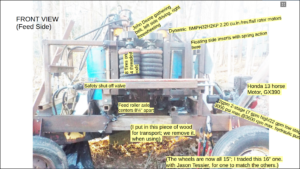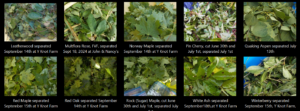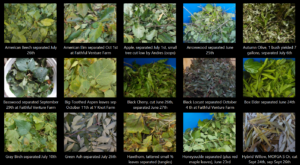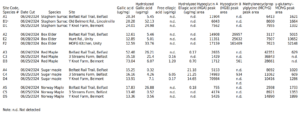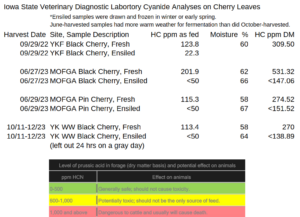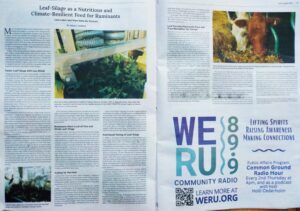Final report for FNE22-013
Project Information
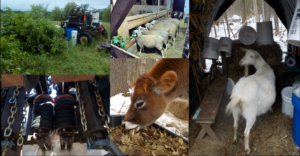
** Report PDF with Table of Contents is downloadable under "Information Products" at end of report. **
This project moved nutritious, climate-resilient temperate woody forages (which are anciently traditional for wintering cattle, sheep and goats) one machine-step forward, so that we were able to produce a large enough quantity of tree/shrub leaf-silage to go beyond previous SARE FNE18-897 palatability-testing and get a sense of how much cattle, sheep and goats want to eat, plus check effects on milk yields of one cow and five goats.
The new machine: Karl Hallen, Hallen Farm and SUNY ESF Willow Biomass Project, created, then I Shana Hanson with helpers used, our new functional and efficient Chain-Flail Leaf-Separator machine prototype to produce leaf-silage along field edges of three sites. Machine components right now would cost about $9,000 (labor depends upon whether you take it completely apart to improve it three times, the way Karl did). The Leaf-Separator takes leaves (and varied amounts of twigs, depending on speed adjustments) off cut branches, tops, or whole young trees, and drops them into a bin. It’s on a farm trailer; we parked it along field edges where we were harvesting.
***See “Results” below for photo-diagram with machine details, and “Instructional Materials” above for Bailey Riordan’s video of a machine demo.***
Leaf-silage harvest: Starting upon Chain-Flail Leaf-Separator machine arrival in fall 2022, then harvesting throughout 2023, we coppiced or
pollarded edge trees/shrubs, selecting from an array of power-tools and hand tools for most efficient approach per site. Cutting, limbing and stacking took us ¾ to 2 person-hours per 30-gallon barrel of leaf-silage, each containing about 50 lbs. = 22 lbs. Dry Matter (DM). Machine leaf-separation took one person 10 to 15 minutes per 30-gallon barrel, varying by tree/shrub species. Separated leaves were simply packed fresh into plastic barrels and sealed.
Yields at two farms were about one 30-gallon barrel every 10½ lineal feet (LFT) of field edge; at MOFGA South Parking field, the yield was less: one barrel per 15 ½ LFT. Limbed cuttings were 40% leaf/60% wood by weight;, so 1 ton of leafy brush cut from 420 LFT of field edge would yield about 800 lbs leaves (and 1,200 lbs woodchip bedding, if one had a chipper with feed-rollers receiving the outflow). We used about 1 gallon of gas per four 30-gallon barrels of leaf-silage ($.95/barrel), and produced 70 barrels-worth total, or about 1 ¾ tons (some was in 5 gal buckets, or in different-sized barrels).
***See “Results” below for photo-folders of separated leaves and harvest activities, plus a barrel inventory and 2 short harvest summary spreadsheets.***
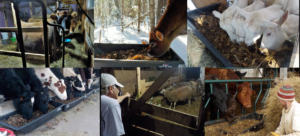
Livestock trials: My 3 Streams Farm herd and farmers/animals at four other farms ran or participated in varied winter trials, meantto determine free-choice leaf-silage intake rates of cattle, sheep and goats, plus effects on milk yields at two farms. Leaf-silage was offered in addition to their usual feedstuffs.
Quaking and Big-toothed Aspen leaf-silages werereadily eaten by mini-Jersey cow, sheep and goats but not by my steer. Over-mature Honeysuckle was readily eaten, yet a lot of twig waste was left by all but the Y Knot Farm sheep.My animals eventually ate Red Maple overnight; including the twigs; Y Knot sheep ate that and Sugar Maple faster. Gray Birch cut in mid-summer was eaten at a much slower rate than our other leaf-silages (a probable harvest-timing issue). Black Cherry, White and Green Ash, American Elm, Black Locust and Red Oak were immediately eaten, withavailability and satiation as the only observed limits.
The steer at my 3 Streams Farm in one two-hour offering-period/day (but he was satiated sooner) ate leaf-silage as 1/3 the Dry Matter (DM) of his grass-/browse-fed (no concentrates) diet, with 2023 late-cut 1st-crop hay offered 24 hrs/day as his other staple. 10 grass/browse-fed goats here in same two hour period/day(with same other feed) chose leaf-silage as over half (55.5%) of their dietary DM.
With just that one 2hr offering/day, the (solely forage-fed) 10 goats and steer together consumed 44% (24.13 lbs DM or 30.16 lbs/day as fed) less hay on average during leaf-silage measurement periods than during 2nd-cut hay periods, which saved $261 across 30 leaf-silage days (minus $34 gas for the Leaf-Separator = $227). These dollar savings do not fully compensate tree/shrub harvest labor, yet controlled field edges with storm-proof pruned trees, firewood bi-product, less weather- and time-dependent harvest, and reliability of deep-rooted multi-year growth in a low hay-crop year, are incentives. One farmer said that he’s cutting brush all the time, anyway (NOFA MA webinar, May 2, 2024).
Winter milk yield (average lbs/day total) from 5 grass/browse-fed (no grain) goats at my 3 Streams Farm with leaf-silage offerings was 92.7% of yield with leaf-silage replaced by 2nd-cut hay offering. Goat Butterfat yield (lbs/day) with leaf-silage offerings was equal to yield with 2nd-cut hay offering. % Milk Solids and other component percentages when leaf-silage was fed were similar to those when 2nd-cut hay was fed.
Milk yield of the Tilden Pond Farm cow rose 8% or 1.625 lbs/day (about 3½ cups/day) when fed about 7 clean lbs/day (twigs removed) of Honeysuckle or Quaking Aspen leaf-silage in addition to her regular diet of 2023 late 1st-cut hay plus 8 lbs raw grain/day.
Yulica Santos Ortega, at Maine Health Institute for Research (but now at a U VA laboratory), identified and looked for differences in relative levels of hundreds of lipids in our goats’ milk from a leaf-silage versus a 2nd-cut hay period; all identified were present in both. See “Results” for her bar-graphs of lipids that differed most. Yulica also compared our milk, from leaf- and hay-periods, with milk of Kaili Wardwell’s goats at Abraham’s Creamery without browse in winter, and with the Tilden Pond Farm cow’s milk without leaf-silage. I hope to enlist a Food Science collaborator, to report human health aspects of these lipid profiles.
Goats’ milk Somatic Cell Count ranged broadly andaveraged67% higher in the leaf-silage periods (this is of concern; further trials are needed).
We redesigned other trials to match remaining leaf-silage supply (my animals ate more than we expected). At Faithful Venture Farm, about 14 mostly Holstein heiffers ate a 30-gallon barrel of Green Ash, Red Oak, Am. Elm orBlack Locust (each species offered on one of four consecutive days) in 20 minutes (Ash and Elm) to 1 hour (Red Oak).
Y Knot (dry, pregnant) dairy sheep ate everything (including twigs) except gray birch, with farmer Susan Littlefield for convenience leaving barrels unsealed across multiple feeding days (grass baleage contrastingly spoils once opened). Meadowsweet Farm sheep and beef cattle more slowly but thoroughly ate two barrels of remaining gray birch.
***See “Results” below for four “3 Streams Trial” & one each of “Tilden Pond Farm Cow Trial” & “Faithful Venture Heifer Trial” spreadsheets, plus Yulica Santos Ortega’s Milk Lipid graphs & spreadsheets.***
Nutritional analyses, expanded by award of additional SARE FNE24-083 (most results are in; see that recent Project Update at ____),confirmed our previous findingsthat though crude protein levels in leaf-silage are comparable to those in grass forages, protein availability is lower. Yet measures of fat, carbohydrates, net energy, and minerals surpass those of average grass forages, affirming our animals’ common sense in their eagerness to consume leaf-silages.
Cyanide (HC) in Cherry species dissipated as expected when ensiled; SARE FNE24-083 is providing additional data.
Toxins in Maples & Box Elder: Award of related SARE FNE24-083 allowed us tobetter addressmaple-species toxins: we hadGallic and Ellagic Acid levels measured, plus looked at relative levels of four additional toxins found in Box Elder, to shed light onmy animals’ limited consumption of red maple, sugar maple, and staghorn sumac leaves, and frequent outright rejection of Box Elder. We had highly edible Norway maple leaves tested for comparison. Each species excepting Norway Maple had the highest level of a different toxin. Box Elder, most dangerous to ruminants, had comparatively substantial levels of four toxins, with Hypoglycin B by far at highest level.
Condensed Tannins (CT): This project’s leaf-harvest, plus ongoing addition of more species and sampling-time in FNE24-083, enabled us to provide leaf-samples to Wayne Zeller, CT expert, US Dairy Forage Research Center. Wayne has so far screened 30 tree/shrub species for relative levels ofCT, and is proceeding to isolate and identify CTin 24of those species with high levels. CT is known to improve ruminant protein utilization, mayreduce cattle methane emissions, and may decrease intestinal parasite loads in sheep and goats.
***See”Results” below for summaries of Toxin, Nutritional, & Condensed Tannin results. See “Results” within SARE FNE24-083 Project Update at ____ for more in-depth discussion & spreadsheets re: these topics. ***
Outreach: We shared our progress and data with: 35 agroforestry-interested farmers through an on-line presentation hosted by NOFA MA (70 more clicked on the recording within one week);170agricultural biomass researchers, foresters, agroforestry students and agroforestry teachers through a poster-presentation and table for the Short Rotation Woody Crops (international) Conference at University of Missouri; 50 farmers in 2 years of presentations at MOFGA’s Common Ground Country Fair, with thousands viewing the Chain-Flail Leaf-Separator display both years;10 tree- and livestock-interested people at the 2024 Maine Permaculture & Agroforestry Convergence, and 33 farmers plus 10 agricultural vendors at the 2024 Maine Forage Conference.
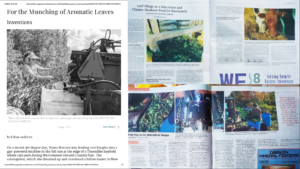
Ethan Andrews’ Free Press article (7/11/2023, p 3), John O’Meara’s Progressive Cattle article (Issue 7, July 2023 pp 32-33) and my own MOF & G article (2024 June-July pp 20-21) recieved widespread readership. A Poor Proles’ Almamac podcast interview of me (recorded just before our award) aired during our project, and a 2nd Poor Proles’ podcast interview has been recorded, toair this coming summer.
***See “Instructional Materials” above for Presentation Videos & Webinar Slides with text added. See “Outreach” below for full-page photos or PDFs of articles, & links to Webinar Recording & Podcast. ***
Project Objectives:
This project sought to complete/perfect machinery and test methods for efficient field-edge production of improved nutrient-dense broadleaf tree/shrub silage, trial how much cattle, sheep and goats would eat as climate-resilient winter supplement, and assess utility/feasibility in comparison to conventional forages.
We:
1. Completed/perfected Karl’s chain-flail leaf-separator.
Are reporting/providing:
-
- Costs of new/used components, labor;
- Leaf/woodchip proportion plus textural photo per species;
- Machine photo-diagram, videos of harvest use & Demonstration Presentation.
2. Obtained Laboratory Results.
-
-
Assessed safety of fresh-stripped and ensiled: Pin and Black Cherry, and took steps toward understanding toxicities in some Maple species (especially problematic in Box Elder) plus Staghorn Sumac, with Norway Maple as non-toxic comparison;
- Examined leaf-silage nutrition alongside animal intake;
- Examined changes, fresh to ensiled.
-
3. Harvested broadleaf silage from 3 field-edge sites with 5- to 20-year growth of 18 broadleaf tree/shrub species using power tools, hand tools and leaf-separator.
-
- Collected/packed/sealed/labeled leaf-silage in barrels.
- Summarized: species, labor-times, costs, leaf-silage yields.
4. During daily timed sessions, offered steer and 10 goats unlimited weighed amounts of leaf-silage or 2nd-cut hay within alternating trial-periods in a 66-day Long Trial, plus trialed a farmer-led ration-plan with 15 sheep, and completed 3 short trials with Holstein heiffers, a mini-Jersey cow in milk, and mostly Angus beef cattle plus sheep.
Measured:
-
- How much leaf-silage versus 2nd-cut hay the steer & 10 goats ate;
- Change in amount of 1st-cut hay they ate, and hay-cost savings plus observations in that trial plus in the rationing trial with dairy sheep;
- Effects on cow’s and goats’ milk quantity and goats’ milk components;
- How fast Holstein heifers ate each barrel per 4 leaf-species, or Icelandic sheep and Angus beef cattle ate 1 unpalatable species-harvest.
5. Compared to other available forages:
-
- Labor & costs per animal utilization, per nutrition, and per yield.
- Farmer-participant observations.
Irregular precipitation is decreasing yields, availability and quality of grass-based forage. Northeastern ruminant farmers are getting used to scrambling differently each harvest season, with farm survival increasingly dependent on creative value-added ventures and/or off-farm income sources. Animals are sometimes leaving a high proportion of grass forage left-overs, picking through for acceptable bites; this makes feed magement and chores harder, plus animal condition and farmer spirits sometimes suffer. It’s hard to be scrambling AND watching a disappointing situation.

European ruminants used to be wintered on tree leaves, from ancient times until grass-cutting equipment surpassed pruning technology in the 1800s. “Foliage is a more reliaable source of fodder than hay, and less dependent on weather conditions” (Austad, Hamre et al. 2003, p 100). Ensiled or cooked leaves were said to be more digestible for cattle (and hogs), than dried leaves as fed to sheep and goats, and even raked leaves were moistened and ensiled (Machatschek 2002, Slotte 2000).. Ingvild Austad, with colleagues and farmers (Austad, Braanas & Haltvik 2003), and myself with interns and farmers (Hanson 2020a), both tested ensiled chipped leafy branches with small ruminants, as lysteria associated with dirt from root-clods in grass silage is less likely in cut (versus raked) tree/shrub matter, with modern soil-free containment (plastic barrels versus a soil-based pit or pile). Those studies, and additional studies (Rydgren et al. 2020, Gabriel 2019, Hanson 2020b) indicated, and this study plus SARE FNE24-083 confirmed, that regenerative harvests of nortern temperate trees and shrubs offeryield, feed quality, animal intake and animal performance potential, to reliably bridge critical stored forage shortfalls.
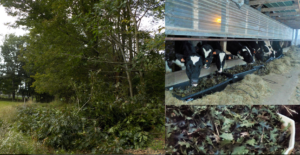
High winds and ice storms are splintering more edge trees into farm fields, increasing maintenance tasks. Some farms remove such hedgerows, increasing wind exposure and losing significant pollinator and bird-nesting habitat. Our harvest by coppicing and pollarding was labor-intensive, yet was an ecological and maintenance contribution (hence Jason Tessier the MOFGA Grounds director’s enthusiastic encouragement). We reinvigoratedclimate-cooling growth, creating ideal nest-sites in new sprout locations. We alsolimited field intrusion, and storm-proofedthose trees and shrubs.
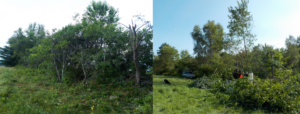

Root-cycling in response to this type of harvest(which can be repeated every 3 to 8 years) releases nitrogen to field-growth, and layers carbon underground, increasing drought and flood resilience of soil (Austad & Losvik 1998,Ninemets &Valedares2006). Such layers of tree root matter may also stabilizesoil for drive-abilityduring grass-silage harvest. In Maine, Silvopasture and Alleycropping just became fundable as Climate-Smart practices (by NRCS, through EQUIP); benefits from top-harvest of trees can now be extended across whole fields.
![Hand-stripping leaves; photo by L. Granlund, 1937, from Nordiska museet, Stockholm, in Slotte (2000), [Part] 1 Lovtakt I Sverige 1850-1950, p 19;. Susan Littlefield, Y Knot Farm, running Red Maple branches through the Chain-Flail Leaf-Separtor, 2023](https://projects.sare.org/media/img/P/h/o/Photo-4-Slotte-and-Susan-Littlefield-stripping-leaves-300x137.png)
Our project-funded Chain-Flail Leaf-Separatormachine prototype was designed to precede a chipper; it reducesthe primary barrier of labor-intensity of leaf-silage harvest, without including woodchips. It producesa high proportion of intact leaves and <5% wood-content, but in 95% less time than traditional hand-stripping.
The unheated SUNY ESF garage in Tully, NY (not a fully-equipped machine-shop) housed Karl Hallen’s work to bringmy day-dream of a Chain-Flail Leaf-Separator into reality. Karl delivered it and stayed to help harvest.
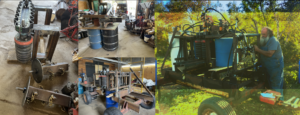
Please DO build more of these; it is intentionally not copyrighted (and too rough to exactly replicate, but it does WORK great!).
***See “Machine” under “Results” below, for the whole story of machine development, list of components with current costs, list of wished-for improvements, and photo-diagram.***

]I measured time-limited free-choice animal intake levels and rates (which may have been especially enthusiastic in that 2023 poor-quality hay year) as a foundation for ration planning. Trials at two farms showed minimal to strongly positive effects on milk yields and milk components. See “Results” for spreadsheets and discssion.
This project catalysed an overlapping, ongoing Farmer Grant, SARE FNE24-083, which has gone beyond our initial plan in addressing gaps in nutritional and toxin data. That information can further farmers’ and researchers’ understanding of possible digestive utilization and effects, and tree species-specific safety issues. See “Results” below for short summaries and spreadsheets, and “Results” in FNE24-083 Project Update at https://projects.sare.org/project-reports/fne24-083/ for more spreadsheets and detailed discussion. (A bit more FNE24-083 data-collection will happen in 2025.)
Wayne Zeller, US Dairy Forage Research Center, Madison WI, is working to isolate and identify Condensed Tannins in our leaf-samples, and plans also to test In-Vitro effect on Methane emissions. Thorstein Garmo (2012) analysed Lipids in Norwegian tree leaves (once I complete this report, I will reach out to him, and/or Google-translate); Andrea Clemensen, Northern Great Plains Research Laboratory, Mandan ND, is pursuing possible leaf-silage Fatty Acid analyses on our leaves. I am very grateful for the efforts of these scientists; we may soon know more of the complexities within this forage. Watch my farm website, https://3streamsfarmbelfastme.blogspot.com in a year or two; I will post their articles.
At my 3 Streams Farm, due to 49(of 70+ total)30-gallon barrels-worth (about 2,600 lbs) of leaf-silage, our grass/browse-fed goat micro-dairy produced milk more steadily than in any previous(or subsequent) winter. At Tilden Pond Farm, John Morse is newly planning to store leaf fodder based upon the successful cow trial there.
At Y Knot Farm Susan Littlefield helped with this project’s leaf-harvest, and will continue to work her field edge for dairy sheep, drying leaves as she has done for years versus making leaf-silage. She finds our machine to be “cumbersome,” plus finds barrels prohibitively hard to open and close. Yet she found value in observations of sheep response while trialing her own leaf-silage ration plan, and saved 1 bale/day of hay in short supply.
Success of our chain-flail leaf-separator machine prototype and livestock trials supports machine improvement for industrial byproduct sourcing, such that large farms might access leaf-silage beyond their own field edges, affordably sans farmer labor. Jason Tessier, Tessier Farm in Skowhegn, ME (and MOFGA Grounds Director), has instructed me on smallest practical sizing of a silage bunker, using landscape-blocks,to try for cattle; small (dirt-free) silos can be tried for sheep and goats.

Karl Hallen (our machine-creator) at SUNY ESF Willow Biomass Project and Art Batson, owner of Lucas Tree Experts (large roadside line-clearing company) remain ready to collaboratetoward upscaled production (despite rejection of ourlarge grant proposal submission this fall). First I want to catch my breath from all these studies, reports and submissions, and work near home, to store a lot of leaves for just my own animals! I’ll be changing my blueberry field road access, to enable use of the Leaf-Separator on my own farm.
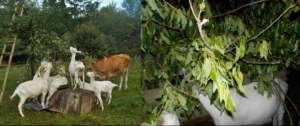
Citations:
Austad, Ingvild, Braanaas, Anders, and Haltvik, Marvin (2003). Lauv som ressurs; Ny bruk av gammel kunnskap. Sogndal: Hogskulen i Sogn og Fjordane (HSF rapport nr. 4/03).
Austad, I, Hamre, L.N., Rydgren K, & Norderhaug A.(2003) Production in wooded hay meadows. In Ecosystems and Sustainable Development - IV Vol. 2 E. TIEZZI, University of Siena, Italy, C.A. BREBBIA, Wessex Institute of Technology, UK and J-L. USO, Universitat Jaume I, Spain, WIT Press, UK
Austad, I. & Losvik, M.H. (1998). Changes in species composition following field and tree layer restoration and management in a wooded hay meadow. Nordic Journal of Botany 18 (6). 641-662.Machatschek, Michael (2002). Laubgeschichten (foliage stories); Gebrauchswissen einer alten Baumwirtschaft, Speise – und Futterlaubkulture. Wien, Bohlau.
Hanson, Shana (2020a). Tree Leaf Fodder for Livestock; Transitioning Farm Woodlots to “Air Meadow” for Climate Resilience.” Accessed 6/16/20. https://projects.sare.org/project-reports/fne18-897/
Hanson, Shana (2020b). Lab Nutritional Analysis of Ensiled Tree Leaves and Ensiled Chipped Leafy Branches, with Dried (non-ensiled) Comparisons, plus Average Grass Fodder Comparison, and Relation to Animal Responses. Accessed 7/20/20. https://www.google.com/url?q=https%3A%2F%2Fwww.uvm.edu%2Fsites%2Fdefault%2Ffiles%2FThe-Center-for-Sustainable-Agriculture%2Fresources%2Fensiled_leaf_fodder_report.pdf&sa=D&sntz=1&usg=AFQjCNE9iymbiW2BMo5pQWXSSTgEA19BzQ
Machatschek, Michael (2002). Laubgeschichten (foliage stories); Gebrauchswissen einer alten Baumwirtschaft, Speise – und Futterlaubkulture. Wien, Bohlau. 542pp., ill.
Ninemets, Ulo, and FernandoValledares (2006). Tollerance to Shade, Drought, and Waterlogging of Temperate Northern Hemisphere Trees and Shrubs. Ecological Monographs, 76(4). 521-547.
Rydgren, Knut, Ingvild Austad, Liv Norunn Hamre, Joachim P. Töpper (2020). Wooded hay meadows as viable production systems in sustainable small-scale farming. Copyright Springer Nature, published online: 28 November 2020. Also, Agroforest Syst (2021) 95:165–176.
Slotte, Håkan (2000). Lövtäkt i Sverige och på Åland; Metoder och påverkan på landskapet. Uppsala: Acta Univeritatis Agriculturae Sueciae, Swedish University of Agricultural Sciences (Agraria no. 236).
I Shana Hanson am the farmer of 3 Streams Farm, and coordinator/laborer/land and equipment owner for Belfast Blueberry Cooperative. I’ve worked pruning orchards since 1983, and shifted to focus more on tree-leaf fodders since 2011. I presented internationally at 2iem Colloque Trognes in 2018, and then lead SARE FNE18-897 and 2019 VTGF projects, which broke ground on tree-leaf storage, palatability, and nutrition.
3 Streams Farm (with 9 goats plus steer, and one work-sow) provides goats’ milk from fresh greenery of woodland and pasture, to seasonal subscribers. Belfast Blueberry Cooperative provides fresh-market wholesale and PYO Certified Organic blueberries each summer, with opportunities for community participation in field care work-trades. Combined gross is $12-$15,000.
Cooperators
- (Educator and Researcher)
- - Technical Advisor
- - Technical Advisor
- (Researcher)
- (Researcher)
Research
1. Completed/perfected Chain-flail Leaf-separator:
a. Karl Hallen Completed fabrication, and delivered the machine at end of September, 2022 (rather than June, as he was delayed by serious injuries).
-
-
Reported potential farmer costs, of components and materials, plus labor/machining estimate, for machine replication (See “Results.”)
-
b. Tested and perfected machine on leafy tree-matter. Karl dis-assembled and re-assembled 3x. We repaired 5x, and improved x5. Designed successfully for safety, full leaf removal/collection, piece-size (intact!), and ergonomic work flow (except that starter cord is a bit high for 5’1” Shana – yet starts on 1st pull).
-
Provided final machine diagram, photos, videos in action. See machine photo-diagram and 2 videos under “Results.” Extensive photo folders and videos of the machine and our harvests can be accessed through a link on the “SARE Grants” tab of our farm website: https://3streamsfarmbelfastme.blogspot.com
***Also Bailey Riordan’s video of our Leaf-Separator demo at the 2024 Common Ground Fair will appear soon, near top of this Report under “Information products.”***
c. Described leaf-product results: Collect 1 bundle/species present at harvest sites, plus harvest micro-sites of 7 additional species (black locust, red oak, Norway maple, elm, box elder, willow and multi-flora rose).
-
-
-
-
Reported % leaf-silage per 4 trees of different species harvested in 2022: Collected and weighed about 5 gallons separated leaf-matter/tree; chipped corresponding stripped branches; measured volume and weighed woodchips. Divided leaf volume and weight by leaf plus woodchip total volume and weight. See 2022 data and discussion under “Results.”
-
Photographed 24 species of machine-separated leaves. See 2 photos of photo-files with species and harvest dates listed in file-names, under “Results.”
-
-
-
2. Harvested 1¾+ tons (77 x 30 gal barrels-worth, some in 5 gal buckets) broadleaf silage from field-edges, using power tools, hand tools and Leaf-Separator prototype:
a. Thinned trees to 10’ minimum spacing, removed growth encroaching into field, and top-harvested (pollard) remaining stems, of 5-20 yr. growth:
~ 190 lineal ft. at Y Knot Farm., Belmont, ME,
~ 700 lineal ft. at MOFGA’s Common Ground, Unity,ME (South Parking Field),
~ 145 lineal ft. at Faithful Venture Farm,
using: Riobe One Plus 18 V Lithium Cordless and Stihl HT56 CE 9 ft. 2-cycle 9-ft. pole-saws; Stihl MS170 chainsaws, and older Huskevarna brush saw at MOFGA only. I used an arborist hand-saw and 10’ Allen Brothers lopper pole at Faithful Venture Farm (these larger trees were very climbable due to good sun exposure. This climbing harvest proved most labor-efficient; yields from large trees are higher than from young trees).
b. Fed harvest through Chain-Flail Leaf-Separator into new large bin placed beneath; arm-loaded into barrels; labelled/recorded species/site/harvest date etc per numbered barrel; sealed, transported, store in shade.
-
-
-
-
Reported: labor-time, costs/leaf-silage yield; tree growth/age descriptions.
-
-
-
3. Livestock Trials:
Assigned palatable barrels (Mini-Jersey refused one oak and one honeysuckle barrel, but liked others of same species. Y Knot Farm sheep and my 3 Streams Farm steer and goats preferred all other species to July-harvested Gray Birch. We did assign them, but they got used slowly, then pssed to Meadowsweet Farm.) I prioritized our 66 day home trial, which ran 1st,, and reassigned/added barrels partway through, to have enough.
Long Trials at 2 farms:
~ Y Knot Farm Friesan-Dorset dairy ewes (15),
~ 3 Streams Farm Saanen dairy goats (5 milking does, 3 young/1 old does, and 1 young buck = 10);
~ 3 Streams Farm Jersey steer (1).
The steer’s mother had died in aftermath of farm interactions with MOFGA Certification Services in summer 2022 - interactions which I initiated around positive PFOS milk tests. Hence our addition of milking trial with the Morses’ cow at Tilden Pond Farm, described under Short Trials below. [PFOS results turned out to be false; the State and MOFGA the organization (Certification was not involved in testing, nor had any guidelines to exclude PFOS) were using the wrong test from 2019 into 2023. That test was listed by the EPA for water only, due to published withdrawal of their own study of eggs in 2008, in which the author explained that the test could not be used on any vertebrate products, due to reading 3 beneficial Cholic Acids as PFOS. We spent that whole summer of 2022 testing for the non-existent PFOS source. If Karl Hallen had been able to provide our machine as scheduled that spring, I would not have had time to use it anyway.]
3 Streams Farm Trial (10 Saanen goats, inc. 5 in milk; 1 is ½ silver cashmere, & 1 Jersey steer):
Starting on December 16,2023, and ending on 2/20/24,
Offered all unlimited weighed amounts of leaf-silage throughout 1½ hrs plus ½ hr to finish eating = 2 hrs, one time per day, for 4 transition days then 7 measurement days = 11 days,
followed by same length transition plus measurement period when I
Offered/weighed 2ndcut hay instead of leaf-silage = 11 days.
Completed 3 rotations of leaf-silage/2nd -cut hay = 3 x (11 L+ 11 H) = 66 days total
but took one day off between 1st leaf-silage and 1st hay periods (so = 67 days), to wander for a couple hours (12/27/23, no snow and a WWOOFer wanted to witness natural browsing. They mostly ate wintergreen; some Red Maple buds, a bit of Hemlock tips that they could reach, side buds of small Balsam Fir.
Description of offerings: Leaf-silage was of 8 species: Quaking Aspen, Black Cherry, White Ash, Red Oak, Green Ash, Gray Birch, Red Maple, and Honeysuckle (approximately in order of amounts offered, most to least, mostly based upon availability from harvests at our 3 main sites plus additional Red oak from Montville).
2nd-cut hay was all from 1 harvest by Dave Flood on 1 field, and seemed highly palatable and consistent. It had high dirt content (due to rain? Dirt was left in troughs by animals).
Feeding methods: 8 goats stayed within the cattle-panel fence, reaching through to 3 utility sleds and 1 plastic bin used as troughs (all except one sled had plywood roofs over to exclude precipitation). 2 goats (the frail oldest goat and the buck with large horns) came inside the Milking Station, to eat from same troughs, but on the other side of fence.
The steer was let out free, to eat his offerings (weighed separately) outside the fence.
Offering methods & Data collection: Each leaf-silage day I generally offered 3 leaf-silage species (one day near end only 2 species were offered). I started by weighing amounts that fit in troughs without losing much over sides. Each time intake slowed (usually due to low leaf % left), I weighed and added more, tallying offerings and remains separately by species. Near end of Offering Periods, I gauged offered amounts to match slowing due to satiation, such that left-overs had low leaf-content.
I chose 2 hr offering periods, based upon observations of slowing from satiation during 1st transition period.
If species had differing palatability, I sometimes offered less palatable first (Gray Birch, Red maple). I kept species either in separate troughs, or at opposite ends of troughs to have remains recognizably separate for per-species records. I offered each species in multiple troughs, to reduce animal conflict.
I weighed remains of leaf-silage or 2nd-cut hay at end of each day’s Offering Period, left the remains for 9 goats to continue to nibble overnight (the buck and steer could not reach through the cattle-panel fence), and weighedagainbefore removing for next Offering Period. Overnight intake was recorded as separate figure, then included in total consumed.
While animals ate offerings, I weighed 1st-cut hay remaining from day before (in 2 mangers and 3 to 5 mesh hay-bags hung on fence), then weighed and added new hay for 24 hrs +/-. I subtracted from previous record to note/chart 1st-cut hay used/day.
This 1st-cut hay was cut near end of August (due to a rainy summer), from a field not consistently cut in previous years (and cut by John Morse specifically for me, due to hay shortage). It included creeping small blackberry (“dew-berry”) vines, fine dead grass, plus new green grass. The animals found it palatable, but less so than leaf-silage or 2nd-cut hay offerings (that 2nd-cut came in at same time as 1st-cut).
-
Charted all forages fed per goats and steer per day, throughout trial (see “3 Streams Trial Chart, Data Entry Copy” and “3 Streams Trial Leaf-Silage & Hay Summary Chart” in “Results”).
-
Computed/charted/compared means of offering intake/day and 1st-cut hay used/day across leaf-silage periods, and across 2nd-cut hay measurement periods (see above-mentioned Summary Chart).
Used estimated body-weights/species to estimate proportions of 1st-cut hay eaten by milking goats, non-milking goats, and steer, so as to compute/report leaf-silage % of diet per animal group.
Weighed milk yields from 5 (unbred) goats;
-
Charted individual goat’s amounts. Computed/compared mean yields per goat and per day, with leaf-silage offerings, and with 2nd- cut hay offerings.
Took milk samples, 1 per goat (5) per Offering Period (6), on one day in middle to end of each measurement period. Sent to Dairy One for Component Analyses.
-
Compared milk components during leaf-silage versus 2nd -cut hay offering periods (see “3 Streams Trial Milk Date, Dairy One” in “Results”).
Examined effects of air temperature, date (= day length), and DM intake on milk yields (see UMaine intern Megan Smith’s graphs in “Results”).
-
Computed milk yields/DM intake.
Adjusted results to account for incrementally longer day-length throughout trial, by discounting 1st leaf-silage period where applicable.
Y Knot Farm Ration Trial (15 pregnant Feisan/Dorset cross dairy sheep):
Starting March 12, 2024 and ending April 21, 2024, farmer Susan Littlefield
Filled/weighed/fed out 3 loose 5 gallon buckets/day averaging 17½ lbs/day as fed, in late afternoon (4 pm-ish) from each leaf-silage barrel in turn until emptied, during
24 measured feeding days = 2 days, then 1 day break and 4 days feeding but unrecorded (she meant as “transition,” misunderstanding the original plan for alternate just-hay measurement periods), then 2 x 11 day periods still feeding leaf-silage, with 2-day break or unrecorded feeding between. (Susan had her notes from talking to me about the trial many months before, and was extremely busy, so resisted clarification.)
then 1 day eak and 4 days unrecorded but kept feeding, then for
6 additional measured feeding days fed increased amounts of leaf-silage,feeding one whole barrel (about 50 lbs),and averaging 32 lbs/day (perhaps in response to my clarification that I originally had promised to report how much the sheep would eat).
These leaf-silage amounts were replacing 1 bale of hay per evening.
The sheep still had some of their morning hay left. Susan knew DM leaf-silage ration was less than ½ DM hay bale, but said her sheep needed to lose weight before lambing. The leaf-silage kept them busy and content.
-
Charted weights fed/day per barrel and leaf-species from Susan’s paper notes, lbs waste left (they ate most twigs and sticks), plus her noted comments.
See “Y Knot Farm Sheep Trial”spreadsheet in “Results.”
-
Computed hay cost saved during EACH Long Trial (See discussion in “Results”).
Short Trials:
~ Tilden Pond Farm Mini-Jersey Cow Betsy (1)
~ Faithful Venture Farm 1-2.5 yr.-old Holstein heifers (14; started out 16, but smaller cattle who escaped had not been getting in to eat much)
~ Meadowsweet Farm Angus cattle (25) and Icelandic sheep (30).
Tilden Pond Farm Trial (1 mini-Jersey cow in milk):
Starting on December 12, 2023 and ending on January 6, 2024, farmer John Morse completed an unrecorded transition testing platability of various barrels, then
10 measurement days, when he
Weighed/recorded/fed about 7 lbs leaf-silage/day leaf-silage total in 2 feedings before AM and PM milkings (John missed feeding leaf-silage 12/18 PM and 12/19 AM, but we still included those milk amounts).
Leaf-silage was Honeysuckle (7 feedings, with Black Cherry fed 1 time mid-way) then Quaking Aspen (11 feedings). John took out all sticks prior to feeding because “she wanted me to,” and weighed them also. (My steer sorted his own leaf-silage to get all the leaves. Susan’s sheep ate the sticks.)
Weighed/recorded milk yield, using an antique deli scale with lbs and oz.
(John’s record-keeping was immaculate. I typed it.) See “Tilden Farm Cow Trial” spreadsheet in “Results.”
Faithful Venture Farm Trial (14 Holstein heifers):
For 4 days starting January 19, 2024 and ending on January 22, 2024, I
Weighed/recorded, distributed into 7 sleds, and fed most* of 1 species-specific barrel of leaf-silage per day (*neeping some out for analyses),of
Green Ash, Red Oak, American Elm, Black Locust (fed in that order), all harvested September-October 2023 there at Faithful Venture Farm.
Timed how long until leaves were gone or cattle intake slowed (or on Red Oak day, I got too cold).
Weighed/recorded left-overs. Reported intake (lbs) and time they took (minutes).
See “Faithful Venture Farm Trial” slides and discussion in “Results.”
Meadowsweet Farm Trial (25 mostly Angus cattle; 30 Icelandic sheep):
On 1 day, April 7, 2024, I
Offered 2 mesh hay-bags of Gray Birch leaf-silage, 1 from Barrel #31 MOFGA Gray Birch harvested July 19, 2023, and 1 from barrel #43 YKF Gray Birch harvested August 3, 2023 by Gedo & Susan, broken puffed lid patched (all summer-harvested with low palatability, left from 3 Streams and Y Knot farm trials) to sheep (who were not very interested), and
Offered 39½ lbs (summer-harvested with low palatability, left from 3 Streams and Y Knot farm trials) leaf-silage from Barrel #26 MOFGA Gray Birch harveted July 15, 2023, in 3 sleds, to Angus cattle, next to their grass baleage, outside head-slot bars.
After 1 hr (intake slowed), weighed remaining leaf-silage. Reported amount eaten by cattle, and observations. (Eliot watched for next few days, removed sleds once all eaten, and reported to me.)
Prior to above day, and for another 10 days or so, farmer Eliot Van Peski fed sheep (same low palatability) leaf-silage from their 2 barrels (above), sprinkling it across their hay each day, until all was eaten.
4. Obtained laboratory results:
a. Measured toxins in wilt-issue species: Collected 5 well-packed gallons separated leaf-matter per species. Drew 3 fresh 1 quart. samples/ species; re-packed/sealed buckets; stored outdoors in shade. In January drew corresponding ensiled 1 quart. samples.
Sent 1 fresh and 1 matching ensiled Black Cherry x 3 pairs and Pin Cherry x 1 pair of samples to ISVDL and determined ppm Hydrogen-Cyanide. See “Results,” thanks to added Northeast SARE FNE24-083 funding (funded by NIFA), and with further testing planned for 2025.
Collected, bagged, froze, transported on dry ice to Megan O’Neill, Georges Road Farm, for freeze-drying, and sent 3 fresh samples per species from similar individual trees/shrubs of Red, Sugar, and Norway Maple, Box Elder, and Staghorn Sumac to MU Metabolomics Center. There they determined ug/mg Gallic Acid and Ellagic Acid, plus each Hydrolyzed, and also relative quantification of 4 non-proteinogenic Amino Acids Hypoglycines A and B (HGA & HGB) and their homologues Methylenecyclpropylglycine (MPCrG), and y-glutamyl MPCrG (these 4 non-proteinogenic Amino Acids are known toxins in Box Elder). See MU Metabolomics chart under “Results.” See SARE FNE24-083 Project Report for detailed discussion and PDF with MU methodology and graphs.
-
Discussed animal response and species-specific safety risks including fresh/ensiled differences of Cyanide in Cherry, in “Results.”
b. Tested nutrition of 1 sample per species fresh leaf-matter, and tested 1 sample leaf-silage per most containers (this meant 3 to 11 tests per species used in the 3 Streams Farm Trial), differing harvest dates, or species, plus 1 test per each of 2 batches of hay that were fed during the 3 Streams Farm Trial.:
We chose to work wth separate species piles, as each stretch had a few species dominating, and harvest strategy (holding either pole chainsaw for pollarding, or brush saw for coppicing) and machine settings turned out to be species-specific. We saved 5 gal. buckets of most species, and bagged fresh and ensiled samples of each species (missed few samples; see “Paired Samples” spreadsheet under “Results”). Barrels were mostly packed with single-species, or sometimes two or more species in well-defined parts of the barrel – not mixed.
We completed stem-counts for 1st few barrels; numbers were too varied and stand-specific to be replicable or useful, and we no longer needed stem-counts to determine plant species proportions in single-species barrels.
We stored full barrels outdoors in shade. In winter, we drew ensiled samples, and froze or sent more immediately to Dairy One Forage Laboratory. We applied and were awarded additional NESARE funding (FNE24-083) for more extensive laboratory analyses.
From each leaf-silage barrel fed (see 4.c. and d. below), we drew about 2½ to3 lbs (into a 5 gallon bucket) from near top, middle, and bottom of barrel, then mix/pack/seal/label/freeze 2 quart bags (one we sent for nutritional analyses; one stored for future research) and 2 “tiny” 2”x 3” bags (which are enough for C Tannin screens and any future mass-spectrometry research).
Shana bought a larger chest freezer in addition to smaller one lent to her, yet freezer space quickly became a limiting factor.
-
Reported all data, plus means per species: MC, DM, CP, SP, DP, ADF, NDF, NFC, WSC, TDN, NEL, NEM, NEG, RFV, pH, and 10 minerals for all samples, Ammonia in ensiled samples, Fat EE and Lignin for all tested after the point at which Michael Reuter, Dairy One, informed me that previous NFC levels were inaccurate due to using grass averages, and Fermentation Profiles meaasuring 4 acids on 4 assorted long-ensiled samples, left into 2nd year (to compare to low to nothing amounts of these acids in 2018-’19 samples tested in VTGF Mini-Grant Project; see Hanson 2020b, cited in “Introduction” above).
See “Dairy One Nutritional Data from All…” spreadsheet, in “Results.”
-
Examined/reported changes from fresh to ensiled. (See “Dairy One data comparing Paired & Ensiled…” spreadsheet in “Results.” See also FNE24-083 in which we ordered sample results by harvest dates/lengths of ensilement.)
-
Observed /discussed animal leaf-species preferences/intake amounts, as the animals discern qualities not tested in standard forage analyses.
-
-
Compared our leaf-silage nutritional data to our 2 hay tests, and to Dairy One average grass hay and grass silage nutritional levels.
See above-mentioned “Dairy One Nutritional Data from All…” spreadsheet, and discussion, in “Results,” plus more info and discussion in SARE FNE24-083 January 2025 Project Report.
-
CHAIN-FLAIL LEAF-SEPARATOR:
To see all sides of this functional creation, open the pdf below:
Chain-Flail Leaf-Separator Machine Photo-Diagram 2025
Following day-dreams: I had thought and consulted (with Doak’s machine, and with AMS, UMaine) about how to design a leaf-separating machine, on and off for years. It came to mind every time I hand-stripped. One day I decided to look at what the logging world had for de-limbers. I decided that a chain-flail de-limber would handle feed-stock variability better than a pull-through de-limber. Both are huge dangerous machines that one approaches from within the protective cab of a loader. (Nothing that comes off the logs is collected.)
I “went” to current Tech Advisor Brett Chedzoy’s Silvopasture webinar, for a virtual look at his farm; I also wanted us to know each other better, to approach him to be my Tech Advisor for a next step (this project!). In the discussion period, I put out a verbal query: “I’m looking for someone to build me a mini chain-flail de-limber, that will just take the leaves off.” Someone fron SUNY was there, and sent me to someone else at SUNY ESF Willow Biomass.
Next day, that person said to call Karl Hallen. Karl answered, and said ”I’ve built one of those before, but it was to make clean wood pellets, so it didn’t collect the leaves.” Then he said he used to dairy farm, cattle then goats.
That fall, our pre-proposal for Novel approaches was rejected. I emailed “We didn’t get it...but I need this machine! You wouldn’t by chance make it in exchange for cheese?” (Y Knot farmer Susan Littlefield had been practicing making aged cheeses with my cow’s and goats’ milk all summer, as some of my usual milk-drinkers were on vacation). He replied that he might do it for cheese : ) I borrowed Susan’s car for the interstate trip, took a wrong turn and arrived at ESF Tully willow Biomss Project in the wee hours, but got Karl to immediately help me finish a Farmer Grant application regardless. Karl returned once there was daylight, to receive a large box of cheeses, jars of milk, box of apples, and bucket of cider. He gave me a quick tour of hundreds of willow varieties, and had me visually show him what size and shape of tree matter needed to run through the hypothetical machine. I had to leave that same morning, to get back and milk goats.
We got that Farmer Grant award (this project!).
Basic machine description: 18 flails=9 per each of 2 vertical rotating square rotors, are attached in spiral pattern; the spiral pattern helps to blow leaves downward into a bin. (Square rotors are not ideal; see “Recommended Machine Changes” below.) Each flail consists of 5 or 6 links (5 on lowest ones so they don’t hit the frame) of 3/8” high-tensile steel chain, large, heavy and durable, such as used to tie a bulldozer to a trailer.
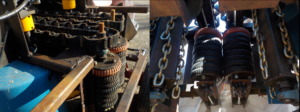
The main feed system consists of ingoing and outgoing pairs of rollers each made by stacking 8 small tires vertically onto 4threaded rods. Branches and trunks must be straight and stiff enough to manually aim across the flails toward center of the rear rollers, as the front rollers pull them in. A wavy interlocking gathering belt assembly for a corn head on a John Deer forage harvester alternatively drags short or floppy branches through the chains from above. Two flow control valves set variable speeds for feed system and flails.
A gas engine powers the hydraulic pump and system. All components are mounted on a 2 axle farm trailer. A large bin, cut to fit, slides underneath once parked, to catch the leaves.
***Machine Demonstration: We hope to have Bailey Riordan’s Video: “Chain-Flail Leaf-Separator Machine Demo, Common Ground Country Fair 2024” under Information Products above near top of this report, soon. ***
Here is a short video, recorded by Colin Yarnell, of myself feeding the Leaf-Separator a long Gray Birch tree-top, with branches "braided" over each other so as not to tangle:
...and a very short video I made single-handedly, that shows how messy our machine was before I added hopper panels and a fitted bin:
Black cherry going into the leaf separator June 27th, set to 9 on flail flow valve
Machine development, technical changes: Karl Hallen broke five ribs, punctured his diaphram, and collapsed one lung falling onto a different machine as he climbed off the fork-lift, in late winter 2022 (he’d have done more before that, but the garage at SUNY ESF, Tully NY is un-insulated). After convalescence, he configured, reconfigured 3 times, and completed our machine fabrication, delivered on September 29, 2022 (we’d originally planned to start harvest in June 2022).
Karl harvested with myself and Susan Littlefield at her Y Knot Farm that day of machine delivery, and the next. After hard use, almost every imported hydraulic hose fitting started to leak. Karl tightened all, and later sent new US-made fittings, for Pat Scribner at Doak’s Machine to switch out (that happened once new leaves came in spring, for Pat to be able to run brush and re-find elusive leaks). Meanwhile that first fall, Susan supplied/applied a lot of rags, to keep oil leakage away from our prized leafy animal forage, and I added plastic bags to wrappings above the flail-chamber.
Post-delivery, Karl also located faster motors to run the flails, which (like many parts) had been unavailable, probably related to COVID19 economic disruptions. He’d actually had to compose the first flail motors from two each, as the correct shank size had been available only on even slower motors. The new flail motors offered an rpm gain of 25%+ (1,500 rpms continuous, at 14.53 gal./min., versus previous 1,150 rpms continuous at 15.5 gal./min.), allowing us fuller use of the flow control valve for much wider choice of flail speed. We could then set the feed-speed flow control valve higher, put brush through fast, and still get all the leaves off.
We were dissatisfied with gap-width between the 2 (John Deere Corn Head) gathering-belts on the top-feed system, designed to feed branches too small or floppy to make it across moving flails from front to rear tire-rollers. Karl wanted branch butts to drop from those belts to the rear tire-rollers, to exit neatly, but a helping hand (usually Susan’s) on the back side was necessary, as branches were dropped too early. Small branches had to be fed in bunches, to be grabbed at all. Shaft gap was unchangeable due to shared use with front/rear horizontal-feed tire-rollers, and excerbated by imperfect function of spring-loading within the left-side frame (iron members probably warped during welding).
[Separate shafts/motors per feed system would have required a larger iron frame over all, and upscaled hydraulic power-pack (= larger engine and probably also pump) to drive the increased number of motors. Such change would have been beyond both our budget and the hauling capacity of my Ford Ranger.]
I found that Jon Thomas, Thomas Bandsaw Mills, Brooks ME, could laser-cut larger sprockets (15 teeth, instead of 11 on the John Deere sprockets) for one side, to close the gathering-belt top-feed gap. Karl thought correctly that we could have the 2 new larger non-drive-side sprockets free-wheel (shafts continue to turn due to shared use with tire-rollers, and differently sized sprocket-pairs must turn at different speeds in order to mesh).
In June 2023, Jon supplied new sprockets, I bought bearings for them (1 pair/sprocket, sandwiching sprockets between to disable the bearings’ “self-aligning” wobble) and Pat Scribner finished all 2023 changes: larger sprockets (including lengthening the gathering belt – we bought a spare one to cut up and patch in), faster motors, and only one slow leak left (below the pump, well away from leaves – 3 people have reduced but not sealed that leak).
In June 2024, I enlisted Jon to make even larger free-wheeling sprockets, with 2 more teeth =17 now, leaving a flexible wavy-belt minimum gap of about 1/3”. Pat again installed (labor was as usual the largest expense). This change improved processing of all small stock, and was required in order to fulfill my commitment to try Multi-flora Rose (it worked!).
As delivered, leaves were supposed to drop directly into a barrel, but too many escaped. If we raised the machine up to allow a barrel hopper, everything else would be too awkward for me to reach (the engine starter cord is already awkwardly high for me, but thankfully starts on 1st pull). For awhile, we used a tarp beneath the barrels. Andres Veles briefly worked as Intern for our 2023 MOFGA harvest, and his competent perspective inspired my additions of metal flashing and plywood beneath and adjacent to the flails, to minimize leaf loss (I can’t really call these surfaces a hopper, as they are interrupted by frame cross-members). I still must reach in intermittently with a garden tool, to free up gluts of leaves in side-portions of patchwork hopper (especially the left side, which has less room between cross-members).I also scoop leaves out of many nooks in the frame before sliding the bin out.See “Recommended Machine Changes” below.
I subsequently cut the large new bin (on-site), fitted closely on all sides. I now slide the bin out, and armload leaves into barrels, putting the barrel inside a corner of the bin to work once there’s room. 8 minutes to move leaves from bin to 2 barrels, while removing stray sticks and packing leaves more tightly (which we did either way), is less than timewrestling with a tarp.
An exhaust chimney was very necessary, and absent until I bent some 2’ flashing lengthwise, crimping a loose French seam by hand on-site. I cut a hole and rolled a short smaller pipe to meet Honda engine exhaust hole, and wired all together. I wrapped another piece of flashing loosely around the large hydraulic pump hose below the base of my chimney, as heat protection. Amazingly, this has all lasted multiple road trips! It saves us from walking directly across the stream of exhaust in order to reach the engine shut-off, plus reduces our intake of exhaust overall while running the machine.
Expense to make such a Leaf-Separator : $16,000 of our grant went to Karl for machine fabrication. Taking into account repeated or multiple purchases of fittings, motors, metal etc. (once tried, or bought for parts to add to another, they cannot be returned – a pitfall of fabrication), and reimbursements for parts Karl had on hand, includingthe Honda engine, and a farm trailer he modifiedand contributed (an after-thought, for instant set-up with barrel/bin access), Karl estimates that all funds went into materials (Karl’s receipts list items for multiple projects; accounting is not his strong-suit, and his sawmill customers were backed up, while he made our machine).
Bad deisel on the way home from machine delivery, with the big truck and trailer, caused extra stay-overs mid-trip, for repair. Karl rented a car for the 2nd trip. His budgeted compensation covered just a standard direct mileage amount. I’d already re-allocated my own stipends to purchase 64 new barrels (which had become unavailable used), and paid out of pocket for some of the post-delivery machine changes, and more intern stipends than planned. We both wanted to make this project happen, and did so beyond budget. Karl ate the cheese, milk, apples, cider, and later blueberries I provided; I at least will enjoy continued use of the Chain-Flail Leaf-Separator and barrels (and send Karl more blueberries).
If YOU were to duplicate this machine, here’s a
Parts & Materials List, with today’s (rounded-off) prices:
$900 Engine: Honda 13 horse GX390
$480 Hydraulic Pump: 22 gpm 2-stage (7 gpm high/22 gpm low stage), 3000 psi max @ 3600 rpm max
$100 Hydraulic Tank: Re-puposed 50 gal propane tank
$400 =$200x2 Hydraulic Motors, for Flail Rotors: Dynamic BMPH32H2KP 2.20 cu.in/rev, 1831 psi cont./2393 psi int., 1500 rpm cont./1650 rpm int @ 14.53 gpm cont./15.85 gpm int.
$230 Hydraulic Motor for Feed Systems: (Dynamic BMPA-315-112-K-P-H-20220130-215 does not seem to exist – discontinued?)
$160 =$80x2 Flow Control Valves
$50 Hydraulic Shut-off Button
$290 Hydraulic Hose, 50 ft.
$500 Hydraulic Fittings (various; get US made to avoid leakage)
$600 Steel for Frame: Cut from (2”x2”x20’)x2 Angle Iron + (2”x20’)x1 Square Tubing + 20’ I-Beam
$200 Welding Supplies
$600 =$200x3 John Deere Corn Head Gathering-Belts, for top-feed system (one is to piece one side longer, to accommodate custom sprockets)
$90 =($35+$10 hub)x2 John Deere Corn Head (11-tooth) Sprockets AH103303; one must cut out the center bearinsg to replace with weldable hubs
$150 =2x 17-tooth Custom Laser-cut Sprockets (Each is 2 layers of ¼” steel welded together; tips of teeth were then bevelled to mimic John Deere tooth shape, for smooth chain entry.)
$640 =$20x 8 (approx. 2” treads, would fit 6” rims) Tires x 4 Feed- & Exit-Rollers
$320 =$20x16x3/4“ Threaded Rods, on which to mount tires above
$120 =$20x6 Shafts: Approx. 1”x3’x6 pieces Round Bar
$640 =$40x16 Bearings: 2 each/6 shafts + 1 pair each/2 free-wheeling new sprockets
$20 Flail Housing: Used 55 gal plastic barrel
$40 Exhaust Pipe (3x4”x2’ Stove-pipe ideally, but ours is aluminum flashing with hand-bent French seam)
$60 Leaf-Catchment Hopper: Some better flat flexible material than the auminum flashing that I used, to line area beneath flails & barrel housing, and funnel leaves into bin
$100 Leaf-Catchment Bin: Re-purposed sturdy plastic 250 gal. tank from road salt, custom-cut/fit (chain-saw)
$100 Nuts & Bolts, Wire, Guerilla Tape
$780 =$130x6 buckets =30 gal. Hydraulic Oil
$500 Shipping (on all parts not near you – total guess – depends where you are)
_____________
$8,070 Total Materials & Components, without Trailer & without Labor
$1,000 Used Farm Trailer with Good Tires
_____________
$9,070 Estimated Outlay without Labor (also with no mistakes nor changing out parts)
$13,500 estimated labor of a Farm Mechanic, figured as 300 to 600 hrs (so we used 450 hrs) at $30/hr. (A machine shop would probably take half the time, but at 4 times the rate/hr, so twice as much $$.)
Recommended Machine Changes:
Cylindrical Flail Rotors: The current square rotors bend, catch and wind up flexible branches of strong-fibered species that do not break (from worst to not-as bad: Hawthorn, Birches, Arrowwood). We suspect that such branches might be more easily pulled through, or off of, cylindrical rotors.
Larger (Pipe?) Frame: As mentioned above, the frame as built does not leave room for any continuous smooth lining nor hopper (so leaves get caught multiple places). Supports for lower flail shaft bearings should protrude inward from cross-members, so that chamber housing or lining does not include cross-members.
Alternatively or additionally, Karl suggests a Pipe Frame, which would have more strength per weight, and less leaf-catching surface.
High-Tensile Chains with Teeth for top-feeding: Karl recommends fabricating these in place of BOTH the gathering-belts and front tire-rollers(the belts were made for corn, are already cracking from our hard use; the tires on front and rear feed-rollers will soon get chewed up by the threaded rods on which they are mounted). One would feed ALL branches and trunks by handing butts up to that chain-feed, rather than having to aim stiff long pieces across moving flails.
The above new Chain Top-Feed System would be strongly Spring-Loaded, so as to grab ALL sizes of stock firmly, and drop exiting butts down to the…
Improved Exit-Rollers: Current rollers are stacks of 8 small tires, mounted on 4 vertical threaded rods per roller (no wheels, so tires squish effectively to grab irregular diameters). We are open to suggestions for a more long-lasting squishy design, but more likely the rollers can be more rigid and share Improved Spring-Loading with the feed-system as a whole.
Control Bar = Safety Shut-Off Bar, on the ingoing feed side of the machine, so one’s body can stop the machine by falling toward it (or being drawn into it – unlikely, but possible). Right now, we just have a small left-hand shut-off button.
Rear Shut-Off Button: With above Control Bar in front, the current Shut-Off Button can then be moved to the back side. Often after walking around, one sees reason to shut off the machine there. (Without chipper, brush piles up, and occasionally tries to re-enter from the exposed sides of feed-rollers).
Accessible Nuts on Tensioning Rods for tightening top-feed belts: As built, the left-hand one is especially directly above the flail-rotor top-plate, without space to engage and turn a wrench. (I succeeded very slowly at tightening by using a 1” wrench sideways on a 7/8” nut.) Karl of course built the tightening system before he placed the rotors.
All in all, these are relatively minor changes. I am quite satisfied with the effectiveness of Karl’s creation.
Leaf results: We had expected the flails would rip up leaves, so we promised textural photos per species. As you can see from these photos of 25 species, most leaves remain intact. Twig inclusion varies per speed settings and species (Cherry and Red Maple twigs are eaten by my animals; Susan’s sheep ate ALL twigs).
Mechanically separated leaves:
Leaf-silage proportion to woody refuse (woodchips):
Leaf/Woodchip Proportions: Chipping branch-wood from 5 gallons of leaves/species separated 2022
Red Maple had the lightest wood, and leaf percentages by weight and volume were similar (chips blew notably farther). This particular Red Maple had large young upright growth with leaves almost directly attached – hardly any leafy twigs, so lots of wood per leaves (it took a large armload of branches to produce 5 gallons of leaves). Red Oak had the heaviest wood and large rigid leaves, so leaf percentage by volume was much greater than by weight – a 5x8’ trailer load yielded almost two 30 gallon barrels of leaves in 1 ½ hrs., (more leaves per branch made up in time for the slowed feed speed to remove these tightly attached leaves). Just 8 small Oak branches produced our targeted 5 gallons of leaves. This Oak is a large and vibrantly leafy pollard, and oaks have high carbohydrate storage ability for re-sprouting (Furze et al/. 2019). The Birch (species undetermined) was our least attractive tree with limited new growth, and yet branches yielded higher leaf percentages than one would expect, probably due to having small short branches containing less wood. The Birch was impractical for our machine, as the very flexible branches do not break when they wrap.
In 2023 we fed the Leaf-Separator all diameters up to 3½“ (which is too large for neighbor Jim’s chipper). These large pieces have lower leaf/woodchip proportion, but are more efficient to feed into the Leaf-Separator. We observed that proportions varied more per specific stand than per species.
2022 samples had butt diameters 2” or less, and provided approximately 40% leaf-matter by weight. Means from this small data set indicate a yield of 810 lbs. leaves per ton of leafy branches, and about 8 yards of leaves for every 9 yards of bedding chips produced.
HARVEST:
Mustafa Gedo at MOFGA, farmer Susan Littlefield at her Y Knot Farm, other excellent occasional helpers (Seamus Blake, Andres Velez, Colin Yarnell, Matthew Crisp, Merissa & Justin MacDonald and their children, Gray, Connor Breen) and I (Shana Hanson) harvested tree/shrub matter and used Karl Hallen’s creation, the functional and efficient Chain-Flail Leaf-Separator machine prototype, to produce leaf-silage along field edges of 3 main sites (plus a few targetted species elsewhere).
Coppicing & Pollarding: We coppiced many shrubs, leaving short stools to re-sprout. Of those, Honeysuckle was most numerous; Arrowwood, Winterberry, and in less quantity Smooth Buckthorn (just 2 small individuals total) we also coppiced. Pagoda Dogwood and Leatherwood we pruned for higher re-growth. We felled trunks of both Quaking and Big Toothed Aspen, and of Gray Birch, to also re-sprout at ground level. When pollarded, Aspens and Birches easily abandon their trunks in favor of root sprouts (Aspens) or stump sprouts (Birches), unless significant leaf-bearing growth is retained to keep the trunk dominant. Dense spacing increased height and decreased foliage, such that we were only able to pollard a few Aspens and Birches at the sunny edge of stands. But as planned, we pollarded choice trunks of many other species (mostly Cherries, Maples, and Ashes) , one every 10 or so lineal feet, to re-sprout at heights above reach of browsing animals, but mostly reachable (for this and future harvests) with my 9 ft pole chainsaw.
Tools Used: At MOFGA we almost solely used hand-held power-tools while walking on the ground, pollarding tops with the 9 ft pole chainsaw. At Y knot Farm, we had pollarded some trunks much higher, leaving multiple sprouting locations, five years or so previous; these trees I climbed for branch removal, before using the pole chainsaw from the ground. At Faithful Venture Farm I climbed with an arborist hand saw, making cuts always in young wood less than 5” in diameter, leaving tall climbable tree structures. One green and one white ash there remain about 35 feet tall; all other trees are now 12 to 18 feet tall.
Labor Efficiency: Cutting and collecting branch matter took ¾ to 2 person-hours per 30-gallon barrel of leaf-silage, each containing about 50 lbs. = 22 lbs. Dry Matter (DM). Pollardng tall fully branched edge trees was most efficient, despite climbing and hand-tool use; as tall leafy faces hold more leaves per lineal foot of field edge (and large wood was left standing, so required no handling). Coppicing tall Quaking Aspen trees was next most efficient, but we did not count stacking or loading trunkwood. Leafiness and vigor of growth also increased efficiency; previously harvested but well-rested black cherry at Y knot Farm in full sun, and mature ashes in their prime at Faithful Venture Farm, were most bountiful; mature gray birch at both MOFGA and Y Knot Farm took longest per yield, as leaves and branches were small, and tendacy to tangle necessitated prep-time of “braiding” branches, as described below.
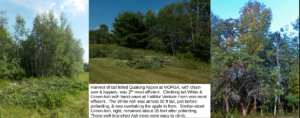
Machine leaf-separation took one person 10 to 15 minutes per 30-gallon barrel, varying by tree/shrub species. Ashes were fastest.

Gray Birch was difficult; branches do not break and easily wound and tangled in our machine. We successfully proccessed 15- to 20-foot top-pieces of gray birch by “braiding” branches inward , laying them across each other working from bottom to top. My goats and steer received a truckload of lower branches of that Gray Birch for fresh eating, after each Gray Birch harvest day (the animals remain our most reliable leaf-separators).

Flexible strong Arrowwood was also very difficult. Over-mature Hawthorn, with angular unbreakable branches and long thorns, tangled consistently (see center photo above) and was impossible to leaf-separate with our machine (the animals were very eager to separate such tasty leaves despite thorns).

Yields varied from about one 30-gallon barrel (each about 50 lbs as fed, or 22 lbs Dry Matter) every 10½ lineal feet (LFT) at both farm sites, to one 30-gallon barrel every 15½ LFT at the MOFGA site (low mostly due to shorter growth, and machine-tangling inseparable over-mature hawthorn which the animals instead ate fresh); 15 ft deep field-intrusion of 18 yr-old Quaking Aspen and Gray Birch there actually yielded one barrel per 4½ LFT and per 7 LFT respectively, or averaging 68 and 70 square feet/barrel.

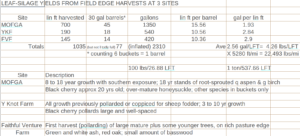

I can fit 12 packed barrels of leaves inside this ¼ ton pick-up truck, but only filled 1 to 4 each 4-6 hr half-day; we or I also untarped and re-tarped the machine, made improvements, took notes and photos, filled sample-bags, dealt with fire-wood and spent brush, etc. (My home herd gets only fresh greenery in summer; the other half of each day I sorted photos and data on attended browse walks.)
Costs: We used about one gallon of gas (for Leaf-Separator plus power tools) per four 30-gallon barrels ($.95/barrel). Barrels were almost $70 each new, but can sometimes be obtained more affordably used, and can be re-used indefinitely. It is possible to set up less costly bulk silage containment for leaf-silage; the barrels offered us transportability, harvest-timing flexibility, and separate sampling of species.
I had huge mileage costs; my farm is mostly wooded, hence our 3 off-my-farm sites, and I can only get away from my home herd parts of each day, so made long trips for low working hours. Hopefully those with on-farm field edges will more affordably pursue such harvest.
LIVESTOCK TRIALS:
My 3 Streams Farm herd and farmers/animals at four other farms participated in winter trials to determine free-choice leaf-silage intake rates of cattle, sheep and goats, and effects on milk production (5 goats, 1 cow) and milk components (5 goats) when leaf-silage is offered in addition to their usual feedstuffs. Animals consumed leaf-silage faster than we expected, and weight of our yield was less than expected. We had filled all available barrels, but our new Leaf-Separator left leaves almost perfectly intact; we had expected leaves to be shredded and dense. The animals tend to PREFER intact leaves, so we were excited about that result. Full barrels at 60-70 lbs (versus the 110 lbs I had experienced with chipped leaf-silage) were easy to load and transport to animals. In consultation with animal research advisors Juan Alvez and Karl Hallen, I shortened and re-designed “short” trials, to supply enough leaf-silage to2 “long” trials.
Our harvest supplied for these trials 1 barrel each of undetermined tastierBirch (leaves looked like Red Birch, but bark is like Gray or White Birch), Sugar Maple, American Elm and Black Locust, and multiple 30-gallon barrels-worth of Quaking (12 barrels) and Big-Toothed (3) Aspen, Gray Birch (12), Black Cherry (12), White (6½) and Green (4) Ash, Red Oak (6), Red Maple (4½), and Honeysuckle (5),plus5 barrels-worth including 3 more tree and 8 more shrub species in buckets and sample-bags.

Favorite species: Black Cherry, White and Green Ash, American Elm, Black Locust and Red Oak were eaten with no limitation except satition. Honeysuckle was prized but left a lot of twig waste; Quaking and Big-Toothed Aspen were prized by sheep, goats and cow, but less than 50% consumed - or later (end of 2nd trial leaf-silage period) rejected entirely - by my steer.
Birch (and possibly Aspen) antifeedant issue: Of 10 species most prevalent at our harvest sites, summer-harvested Gray Birch was least eaten, with animals at both my 3 Streams Farm and Susan Littlefield’s Y Knot Farm leaving ½ or more in our offering-periods, or about 1/3 when left overnight (and it was most laborious to harvest). This low intake may have been a harvest-timing (leaf antifeedant) issue, exacerbated by abundant inedible shattered catkins. Spring- and fall-cut Gray Birch both fresh and ensiled are often well-eaten. Availability of tastier species also magnified animal reluctance. Strangely, and as mentioned above, my animals thoroughly ate leaves off the July-harvested side-branches fresh (and could easily leave catkins hanging).
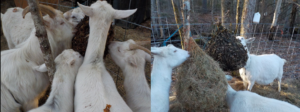
* The preferred 2022 fall-harvested Birch, mobbed by goaats in above photo, had leaves similarly shaped to those of Gray Birch, yet not so shiny. I'm wondering if that tree at Susan's might be European White Birch, which would magnify animals' preference beyond the preferred fall harvest date.
Susan’s sheep at Y Knot Farm similarly loved that 2022 fall-cut mystery Birch, and left so much of the summer-cut Gray Birch that she gave me those 5 barrels back.
Meadowsweet Farm beef cattle and sheep accepted that less palatable summer-cut Gray Birch when fed in lower quantity per head. Farmer Eliot Van Peski used up leaf-silage from 2 barrels by sprinkling it on top of the Icelandic sheeps’ hay each day, for almost 2 weeks; he said thay seemed to value it. Certain Angus beef cattle ate well from another barrel, eating 19 lbs of 39.5 in 1 hour (this is same proportion my and Susan's anmals finished; did the catkins get too concentrated, at that point?). In 4 days they completely finished the left-overs (my goats and Susan's sheep never finished theirs). It probably helped that neither sheep nor cattle were right then receiving tastier tree/shrub forages.

I saved 3 barrels of that 2023 MOFGA July-harvested Gray Birch over and fed in winter 2024-’25, to see if longer fermentation had caused preference; this winter they have little leaf-silage (but lots of fresh Red Maple tops) so were appreciative, but still ate it much slower than they did that 9/30/22-harvested (and possibly species-different) Birch.
Based upon experience with my herd, White Birch has date-related palatability variance, similar to but much less pronounced than Gray Birch; Yellow Birch is eaten all season. Within past SARE FNE18-897 I found Quaking Aspen to be preferred similarly (but even less strongly) in spring and fall.
Also my animals tend to prefer foliage of mature trees to that from young stems, which seem appropriately more defended; Jogia et al., 1989 state that hares (also) tend to prefer mature twigs to new sprouts in general (citing Klein 1977 & Sinclair & Smith 1984). This is consistent with the “‘plant defense guild’” hypothesis (discussed by Jogi et al., pp. 191-192) of evolutionary interaction. We observe pollarded (young, vigorous) growth from mature tree structures (harvested after an approprite 3 to 8 year rest-period) to be most choice. [An aside: Interestingly, pollarded growth on Holly in England is nearly thornless, while lower over-browsed branches become fiercely thorny.]
Gray Birch can become especially abundant when blueberry fields are not well weeded. Within related SARE FNE24-083, I’ve added full-season 2025 plans for palatability testing of young coppiced Gray Birch of various ages from my blueberry field at multiple harvest dates, to better understand seasonal and age-related browse dynamics of this forage resource. As yet I have found no literature regarding what chemical defenses might cause animals’ mid-summer Gray Birch refusals.
Maple Species Toxins:

In my home trial, animals ate small amounts of Red Maple eventually, if I left it overnight. In the Y Knot Farm trial, Susan’s sheep ate our only barrel of Sugar Maple, plus 2½ barrels of Red maple, but she fed each barrel over multiple days, as did I. Our small herds (11 and 16 head respectively) ate whole barrels of preferred species in less than 2 hours.
MU Metabolomics Center, in our tests funded by additional SARE FNE24-083, quantifiedGallic and Elagic Acid levels, and relatively quantified 4 non-proteinogenic Amino Acid toxins, for us to better understand what might be limiting consumption of Red and Sugar Maple leaves, plus “Ash-Leafed Maple” AKA Box Elder* (which caused death of a goat at a farm near me) and Staghorn Sumac* (not a maple, but said to have a similar Gallic Acid issue). We included Norway Maple* for comparison (*these last 3 species were not present in quantity at our 3 harvest-sites, so were not fed in trials, but do appear in our nutritional spreadseets).
***Above Metabolomics spreadsheet is re-printed from SARE FNE24-083 January 2025 Project Update. See that report for more detailed discussion of these specific toxins.***
Norway Maple was confirmed to be non-toxic, and animal intake in past has seemed non-date-sensitive and unlimited (but we did not have enough in our 3 sites to fill a barrel). Norway Maple bark is less palatable than Red Maple bark (so young trees are more likely to grow up past goats), and twigs are easy to snap for hand-harvest; these attributes and nutritional appeal all make sense, in light of long European history of domestic ruminants and tree forage use.
Toxins above (Gallic & Ellagic Acids, and Hypoglycines A & B with their respective “homologues” MCPrG and y-glutamyl MCPrG) are said to increase throughout the growing season. We sampled rather early (June 24-25); my goats and steer accepted Box Elder at that time. On July 20th, they refused Box Elder from a different tree (my animals have many choices on long free browse-walks daily; the goat that died was in a stall with limited choices). Note variance between same-species samples above (3 samples/species), even with same harvest-date.
Hydrogen-Cyanide (HCN or Prussic Acid) in Cherry leaves: We fed many barrels of Black Cherry, in both Susan’s (Y Knot Farm) and my (3 Streams Farm) trials. Cherry was a top choice for sheep, goats and steer. Iowa State Veterinary Diagnostic Laboratory (ISVDL) analysed 4 fresh/ensiled sample-pairs for us, 3 Black Cherry, 1 Pin Cherry. Spring-harvested and wilted Cherry leaves are said to have highest levels; our earliest-harvested (June 27th) fresh Black Cherry indeed had highest Cyanide level, but barely crossed into the “should not be the only feed” category. Cyanide dissipated during ensilement, in all pairs.
Dr. Radke at ISVDL regularly tests Bromegrass for Cyanide, and says 60 days ensilement of that is a commonly accepted safety measure. We will be testing Black Cherry at more harvest-dates and stages of wilt, this coming growing season for SARE FNE24-083.
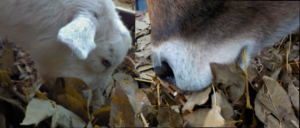
Free-choice intake rates:
The Jersey steer at my 3 Streams Farm in 1x 2 hour offering period/day (during 3 leaf-silage periods of 4 transition days + 7 measured leaf-silage days = 11 days each, within our 66-day trial) ate 2 to 3 species/day of leaf-silage as 1/3 the Dry Matter (DM) of his grass-/browse-fed (no concentrates) diet, with late-cut 1st-crop hay offered 24 hrs/day. He may have chosen more leaf-silage; I slightly limited offerings to him, to assure sufficient supply for the goat milking trial. 10 grass/browse-fed Saanen dairy goats here in same once/day 2 hr. offering periods chose leaf-silage as over half (55.5%) of their dietary DM. I suspect all animals would have consumed that much again, if I had been able to provide offerings 2x 2 hrs/day.
3 Streams Trial Chart, Data Entry Copy
3 Streams Trial, Leaf-Silage & Hay Summary Chart

At Faithful Venture Farm, I offered a bit less than one 30-gallon barrel per each of 4 consecutive cold January days (less because I took samples), to 14 mostly Holstein heifers (+ or -; started with 16, but on various days one escaped and got moved). Each day I fed out just 1 leaf-silage species: I timed their consumption, and noted individuals’ participation. One submissive young heifer tried but never got any; all others ate shoulder-to-shoulder along 7 plastic utility sleds used as troughs.
See my mini-presentation of the Faithful Venture Farm trial below:
Faithful Venture Farm trial, Jan 2024
We experienced eager animal intakes, yet I must mention caveats:
Quality of 2023 hay that animals in our trials had as their staple forage was poor; even Meadowsweet Farm's purchased baleage that year was poor. Also, my animals and Susan's are very familiar with tree forages.
Outside of our Project's trials, Nathan Zimmerman, Palmer Hill Farm, offered a barrel of hybrid willow that I harvested in October 2024 to his 3 groups of grass-fed cattle (milking Jerseys, Jersey heifers, and Angus x Jersey beef cattle). They were completely satisfied with his excellent 2024 spring-cut grass silage, kept in a tll silo. They were not interested in my late-cut willow, that MY animals all devoured. This may have been due to habit, but more likely they simply had high-quality feed. Nathan and I will be offering them some willow from the same stand but cut in June, NEXT season (I'm curious). They do have a browse-line on the trees, there.
]Hay cost saved: With just that one 2hr offering/day, the steer and 10 goats together consumed 44% (24.13 lbs DM or 30.16 lbs/day as fed) less hay on average during leaf-silage measurement periods than during 2nd-cut hay periods. The difference was most of a rare 2nd-cut bale/day @$10/bale at harvest(I was lucky to get any, in wet 2023), minus a bit more total 1st-cut hay eaten, when leaf-silage was offered (that was the steer, who filled up faster on 2nd-cut hay than on leaf-silage; the goats actually ate less 1st-cut hay in leaf-silage periods). I saved $8.70*/day on hay x 30 days of leaf-silage in our trial = $261 (minus $25 gas for the Leaf-Separator = $236). [*Priced at harvest; prices doubled that winter.]
Susan Littlefield at Y Knot Farm had hoped to do a summer milking trial with our leaf-silage, but the State did not arrive for re-licensing. Then she got too busy. With short hay crops State-wide including her own, her butcher had no openings until February. She bought $50/100 lb bale NY timothy and alfalfa hay, to hold her lambs ($12/45 lb bale local hay was too poor quality for growing stock). Then Susan re-licensed and refurbished her store and hot-dog stand, and perfecteda Gyro Sandwich recipe to recoup costs of her lamb meat; I was grateful for her to run the trial at all.
Susan saved 1x 45 lb bale/day of hay x $12 for 30+ days = $360+ (she missed recording some of the days – we think it was 33 days), by rationing out 15½ barrels of leaf-silage to her 15 Freisan x Dorset ewes. She judged them to be too fat, and said if she followed my original plan to determine how much they would eat, the sheep would simply eat everything offered. “There’s a thing called over-eating disease,” she told me. I didn’t argue; we moved on to a taste-test of the Gyro samdwich.
Susan didn’t identify each barrel from the typed list I provided(her barn is quite dark), so we may have misidentified some species, as noted. The sheep ate almost all twigs of all species except July-harvested Gray Birch, which Susan stopped offering early on, due to her ewes’ lack of interest. See spreadsheet below, which I created from her paper notes.
Y Knot Farm Sheep Trial, March 12 thru April 21, 2024
Our hay dollar savings did not compensate for tree/shrub harvest labor, nor for our purchase of reusable barrels (as previously mentioned, silage bunkers would be more economical). Controlled field edges, firewood, and reliability of deep-rooted multi-year growth, harvestable in short flexible time-frames regardless of moisture, are incentives. One farmer said that he’s cutting brush all the time, anyway (NOFA MA webinar, May 2, 2024).
Animals indicate that nutrition, health and happiness are also incentives to feed leaf-silage; details await more research (see “Condensed Tannins” and “Fat” under “Leaf-Silage Nutrition” below).
Winter milk yields of 5 grass/browse-fed (no concentrates) Saanen goats at my 3 Streams Farm rose generally over the 66-day trial, correlating loosely with day-length. Over all, longer day lengths should correlate with rising DM intake throughout (and hence more milk). Exceptions were the 2nd (BL) Leaf-Silage period, in which everyone ate less DM than in any other period (possibly weather-related), and 3rd (CL & CH) rotation, when goats ate more DM in the Leaf-Silage period than in the Hay-Only period. [Perhaps this change was because I had taken more (very choice) barrels from Faithful Venture Farm at the end, and so added leaf-silage more readily, when they slowed down picking through it. I was finally sure that we had enough to finish the milk trial.]


Since each of 3 (11 days each = 4 transition + 7 measured days) leaf-silage periods preceded each 2nd-cut hay period, I am choosing to compare milk yields during leaf-silage periods B & C to 2nd-cut hay periods A, B & C, in order to equalize day-length.
When thus discounting the 1st leaf-silage period to control for day-length, my does gave 6% less milk in leaf-silage periods than in 2nd-cut hay periods. But they also ate 4.9% less 1st-cut hay (offered 24 hrs/day) in leaf-silage than 2nd-cut hay periods. Average leaf-silage and 2nd-cut hay Dry Matter (DM) intakes (during the 2-hour daily offering) were equivalent; the 4.9% difference in 1st-cut hay intake caused 3% less total DM eaten in leaf-silage periods than in 2nd-cut hay periods. Goats’ milk yield per lb DM intake in leaf-silage periods was 98% of that in 2nd-cut hay periods (0.0088 lbs milk difference/lb DM eaten = 14 oz milk difference/100 lbs DM eaten).
3 Streams Trial,, Milk & Butter-Fat Yields per goat per day, plus Summary Charts
3 Streams Trial, leaf-silage, hay & milk, summary computations
Our leaf-silage had much higher energy/lower fiber than hay, leading to less dietary volume needed, but had less protein (and less protein availability) than the hay (see “Leaf-Silage Nutrition” below). In my goats’ forage-only (no concentrates) diet, protein level limits winter milk production, but does not seem to affect Butterfat yield.
Goat Butterfat lbs yield differed insignificantly between leaf-silage and 2nd-cut hay periods; significantly higher Bfats percentages in leaf-silage periods compensated for slightly lower milk yields.
Goats’ milk Component Analyses: Outside of original project commitments but out of curiosity, I sent* 1 milk sample/goat from each of the 6 measured leaf-silage or 2nd-cut hay periods to Dairy One for analysis. This low number of samples, especially with variability of individual goats, does not offer conclusive data, but gives an indication of possible leaf-silage (versus 2nd-cut hay) effects.
(*Glendon Mehuren at Faithful Venture Farm asked the Organic Valley driver to transport my box of frozen samples with their own, directly to Dairy One, as there is no same-day shipping from our area.)
Butterfat (Bfat) percentage averaged 16% higher in leaf-silage periods than 2nd -cut hay periods (x lower milk yield in leaf-silage periods = same Bfat lbs yield across periods, as mentioned above). Lactose was slightly lower in leaf-silage periods. Total milk-solids in leaf-silage and hay periods were equivalent. Somatic Cell Counts (SSC) varied broadly, with higher leaf-period average; these are of concern for dairy licensing. Other milk components did not differ significantly between leaf-silage or 2nd-cut hay periods.
3 Streams Trial Milk Data, Dairy One
Lipid Identification in goats' milk, with/without leaves, and comparison to cow Betsy (below)'s milk without leaves : Yulica Santos Ortega, previously at Maine Health Institute for Research, now at U VA, showed up with her family to harvest blueberries with us, and later offered to do an immense amount of pro-bono laboratory work. the whole family plus child-friends came up for milk sampling (plus music and steer riding), then Yulica identified hundreds of lipids in our goats’ milk with leaf-silage and with 2nd-cut hay. She graphed those with greatest difference between tretments (leaf-silage versus 2nd-cut hay):
Here are ALL the lipids she identified:
Yulica also compared one goat's samples, with leaf-silage and with 2nd-cut hay, to the Tilden Pond cow's milk post-trial (without leaf-silage):
(*Some of these results are over my head. I await further explanation from Yulica, or other knowledgeable scientist.)
Milk yield of the mini-Jersey cow at Tilden Pond Farm was higher by 8% or 1.625 lbs (about 3½ cups) per day cross 10 days, when John Morse fed cow Betsy about 7 clean* lbs/day of Honeysuckle (with some Black Cherry also on 1 day) or Quaking Aspen leaf-silage, in addition to her usual diet of late 1st-cut hay plus 8 lbs raw grain/day. Her average daily yields were 21.81 lbs with mostly Honeysuckle (some Cherry), 21.74 lbs with Quaking Aspen, and 20.15 lbs across the following* 10 dayswithout leaf-silage. (These were decent mini-cow yields; Betsy was milking on just 2 quarters). Betsy’shigher milk yield with leaf-silage was despite of very loose stool (from the dietary change?), and in spite of shorter days of the Winter Solstice during the leaf-silage period.
(*No twigs; John spent much untimed prep-time, as the cow convinced him to remove them all.)
(**John took a break on 1 especially rainy day when he had too much else to do.)
Tilden Pond Farm Cow Trial, leaf-silage & milk amounts

LEAF-SILAGE NUTRITION:
Leaf nutritional analyses indicate low Soluble Protein (<2% of DM on averge, versus 14.5 and 33% in our 1st- and 2nd-cut hay samples respectively), and low Rumen-Degradable Protein (2.5% DM averagae, versus 5.8 and 13% in 1st- and 2nd-cut hay samples), with exception of our one Autumn Olive sample cut July 5th, 2023 (). Hauge, Garmo and Austad (in Austad & Hauge 2014) reported that young leaves in general are as high in protein as grasses (25-30% CP), but that protein decreases as the season progresses. They cite Garcia Plazaola et al. (2003), who found that shaded leaves are often higher in protein than those in full sun. We harvested no north-facing tree-lines, nor did we cut spring leaves. One can surmise that, as with grass, higher protein is a trade-off with lower yield of an early harvest, and also may tax plant/tree energy reserves. Cutting in shade may also diminish yield, or jeopardize regrowth. Many farmers feed early-cut grass silage, which provides a surplus of protein to their cattle, so can supplement with energy-rich leaf-siilage cut anytime, regardless of leaf protein content.
There was about ½ as much %DM of Digestible Fiber in our leaf-silages as in our grass hay, and more than twice the %DM of Non-Fiber Carbohydrates as the grass hay (39% versus 14 and 16%), slightly higher % DM of Water Soluble Carbohydrates (9.9% versus 9.7 and 7.5%), much higher Crude Fat Ether Extract (6% DM; grass forages average 2- 3%; see further discussion under “More about Fats” below), and almost 2x the Calcium as our hay samples, plus other high mineral levels. Total Dietary Nutrition scores across our 10 most plentiful leaf-silage species averaged 62.3; our 1st- and 2nd-cut hay samples scored 55 and 57 respectively.
Net Energy projections were 22% to 36% higher for leaf-silage than for our hay samples. The 36% was NE Growth, which may be inaccurate due to use of high Crude Protein figures without taking into account low protein availability.
Dairy One NUTRITIONAL DATA from ALL 2022-'24 LEAF-SAMPLES analysed
Dairy One data comparing PAIRED FRESH & ENSILED leaf-samples (I appologize for imperfect layout on this one, as PDF.)
Most information in above spreadsheets was funded through our related add-on SARE Farmer Grant FNE24-083. SARE is funded by the National Institute of Food & Agriculture.)
***For more in-depth discussion, and additional spreadsheets comparing harvest dates of our leaf-silage, and fermentation acids, see the SARE FNE24-083 January 2025 Project Update.***
More about Fats: Fat EE level in our leaf-silages averaged 6% DM = 150% of that in average Dairy One grass-silage.
Hauge, Garmo & Austad (pp 74-75 in Austad & Hauge 2014) wrote (my English notes from the Norwegian – thank you to Yvonne Taylor, past Black Locust Farm farmer, for translating to me a few years ago) :
“The fat content is high in leaves (5 – 7% DM), as compared to grass (1 – 3%).The reason is that the leaves have a thick, protective covering. This layer serves as a defense against parasites, and reduces water loss... The outermost layer (cuticle) is built from a cutin and wax that doesn’t have any nutritional value. Leaves from birch often have a higher content of fat than leaves from willow, vier, or, aspen, and rowan. The least fat content is found in elm, ash, linden, and hazel. Like in grass and clover (trifolium species) it is [linolensyren = Linolenic acid = ALA acc to Google] that is most prevalent in leaves (35 – 45% of total fatty acids) (Garmo 2012).”
In light of this, our leaves should have around 2.4% DM Alpha-Linolenic Acid.
Our ensiled leaves consistently had more fat than fresh leaves (averaging 111% of fresh level). Perhaps the rise is in wax coatings, as the leaves suffocate? Or do the wax coatings break down to become digestible fats?
As mentioned above, Yulica Santos Ortega (previously at Maine Health Institute for Research, but now at U VA) identified hundreds of fats in our goats’ milk with and without leaf-silage.
Now Andrea Clemensen, Research Biologist at Northern Great Plains Research Laboratory, S.W. Mandan, North Dakota, is talking to those at their partnering USDA laboratories to see if they can identify lipids, fats or both, in leaf-samples fed in my 3 Streams Farm trial on dates of Yulica’s milk sampling.
***See my summary of Yulica’s findings, & Yulica’s graphs, in the NOFA MA Presentation Slides with Text Added, under “Informational Products” below.***
Condensed Tannins (CT): Wayne Zeller, US Dairy Forage Research Center in Madison, WI, screened tiny fresh (and one ensiled: Quaking Aspen) leaf-samples from our 2023 harvest plus additional 2024 samples. Now he has started isolating and identifying tannins from larger samples of 20 species rating “5” or higher for CT content, on a scale of 1 to 10. (This collaboration goes beyond our SARE committed research plans; thank you, Wayne.)
The above list does not include 2024 samples just screened this January, as specific ratings were not assigned in that 2nd screening, though all but Staghorn Sumac clearly scored >5: Below is a look at tht Jaunary 2025 screening: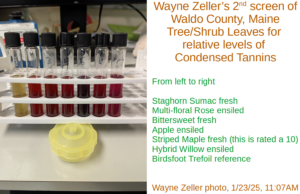
***For slides of Wayne’s 1st CT Screening, see SARE FNE24-083 January 2025 Project Update.***
Citations:
Austad, I. & Hauge, L. (2014). Trær og tradisjon. Bruk av lauvtrær i kulturlandscapet. (Trees and tradition: Use of leaf-trees in the cultural landscape.) Fagbokforlaget. ISBN: 978-82-11-01905-9.
Jogia, Madhu K., Sinclair, A.R.E., & Andersen, Raymond J. (1989). An Antifeedant in Balsam Poplar Inhibits Borowsing by Snowshoe Hares. Oecologia 79: pp 189-192
In context of weather-related low or poor-quality hay yields, we sought to improve and measure efficiency and yields of field-edge harvests of leaf-silage from woody trees and shrubs, which often encroach into fields, or drop branches and trunks onto fields of Northeastern farms. We also explored what proportion of ruminants’ diets can be replaced by such forage within time-limited daily free-choice feedings, while supporting animal well-being as evidenced by milk yield.
We accomplished above aims. Our results strongly increased farmer willingness to try leaf-silage with their herds: In context of a larger grant proposal (which failed to receive funding), I asked 4 farmers who’d never used leaf-silage before, whether they would run trials, and all 4 readily agreed to do so. One is herdsperson for a Somali Bantu community organization; the other 3 are dairies, or diversified dairies, feeding 35 to 70 head per farm of cattle or goats. The 4 farmers involved in trials of this completed project (and myself = 5) also remain willing to participate in further leaf-silage trials, and 2 (plus myself = 3) are increasing their own leaf-harvests.
This project’s budget became restrictive due to economic shifts during the COVID 19 crisis, affecting barrel and machine component availability and raising prices; this left less funds for all else, thereby limiting leaf-silage analyses to a small number of samples. As planned, we applied and accessed further funding for extensive nutritional and toxin analyses (plus improvements to web outreach). Hence, to avoid redundancy, my choice to reference the SARE FNE24-083 January 2025 Project Update, for more comprehensive nutritional- and toxin-specific discussion than I have included in this (much broader multi-faceted) Final Report.
Findings from unexpected pro-bono collaborations with Wayne Zeller on Condensed tannins, and with Yulica Santos Ortega on Lipids in our milk (with possible follow-through by others on lipids in leaves), have potential to increase value of leaf-silages, due to benefits beyond those shown by standard forage tests. Higher forage value can increase ease to fund mechanical improvements for efficient large-scale production. Large-scale production in turn can increase ease to fund further research on ruminant, and human-health related product, benefits. Vitamins, and Volatile Organic Compounds (which may affect shelf-life as well as health), are also of interest and have yet to be explored.
Positive and enlightening data from analyses both planned and unexpected, is causing me to juggle multiple balls of collaboration, while trying to finish this Final Report. Our data strongly supports both leaf-silage use on farms, and further research of positive leaf-silage qualities. This month I supported publication of Jaime Garzon’s UMaine Cooperative Extension Bulletin containing our tree/shrub nutritional data for farmers, supplied leaf-samples to the above-mentioned active ongoing Condensed Tannin USDA ARS research collaboration with Wayne Zeller, and initiated a hopefully 2nd USDA ARS research collaboration on fats.
Our field-edge side-canopy leaf-silage yields were more plentiful than expected, and can be upscaled on-farm within alley-cropping or silvopastural field layouts. Such farm layouts are on the increase, newly funded* through NRCS (for 2025 in Maine) as Climate-Smart practices. (*Re-reading this a few days before submission, that funding may be on Federally ordered “hold.”)
Leaf-separation was quick with our new machine; initial harvest and handling of over-grown woody material remained labor-intensive. We were not funded at a level to support acquisition of a really fast Giraffe circular saw such as used on roadside power-lines, nor even a “cherry-picker” lift, and neither of those pick up the brush. Some orchards have mechanical pruning systems which cut side and top on rows of trees simultaneously; in England, such equipment is used on hedges. Farmers need that sort of machine to mechanically collect branch-matter before chipping, or we need to perfect the sorting of leaves from chips.

At 2iem Colloque Trognes (Sare, France, 2018), demonstrations included cutting equipment able to reach sideways, which also grasped and placed cuttings (used for small-scale biomass); at SUNY ESF Willow Biomass, our machine-creator has thoughts (but not funding) for post-chipping leaf-separation. Our nutritional, ruminant intake, and milk yield/component results encourage further efforts toward additional mechanical harvest-labor improvements, and also pursuit of off-farm industrial sourcing.
Due to managing incoming data from both projects (and collaborations), my own leaf-harvest was low to non-existent in summer 2024. My animals are receiving our usual tasty winter-cut Red Maple twig/bark staple in an on-site woodland yard, plus decent unlimited hay. Milk yield is 17% less than during last winter’s leaf-silage trial, but it is really their excitement and scramble when they see a rare barrel in my sled, which has caused my own commitment to fully use the Chain-Flail Leaf-Separator again in 2025, and re-fill every barrel this coming leaf-harvest season. Animal happiness = farmer well-being.
My own barriers are that my animals want to eat all I cut, immediately. Also, most of my woodland is Red Maple; winter-cut branches are preferred to Red Maple summer leaves. Winter branches are EVEN MORE labor-intensive than leaves, as they must be fed intact, and be turned daily for bark access to opposite sides. But this is what I do, as I have not been able to get ahead of appetites of 8 to 10 goats plus steer yet, harvesting tastier leaf-species in summer, by myself.

In this study I had help of interns and volunteers, and went places without my animals, to harvest mostly non-Maple leaf-matter and fill our barrels. I made it up to the animals by sleeping in places with reachable Smooth Buckthorn. (We already have that habit each year during blueberry harvest; that year we had to wander farther, so as not to kill our sustenance.)
To fully use the Leaf-Separator, I must commute to my blueberry field, enter (cut a road) and change parts of that woodland (with higher non-Red Maple proportion), and change those field edges, which are more extensive than those of my small home pasture. Tree canopies must be reduced consistently across or along an area, as sprouts are light-dependent. It is hard to move or leave the herd, so for me this means incremental treescape change over multiple years. Yet the animals cheer on my progress, toward supplying summertime forages year-round.
In historic Europe, certain species-rich woodlands were developed and tended for forage over centuries, in order to store winter forage (Austad & Hauge 2014). Think what joyful animals, in such a set-up! The sometimes thousand-year+ lifetime of a pollarded tree meant dense harvests: Lineaus in the mid-1700s, in Sweden, got 80 to 100 sheaves per basswood pollard; harvest of just 33 such pollards/year in a 3-year cycle (100 trees total) provided 100% of winter sustenance for his 12 sheep (and supplied his rope business with bast; Read 2003).
This study confirmed modern Northeastern utility of such forages, and quick separability of leaves from wood. Our labor and time investments of either initial harvest of existing trees, or 15 year development of NRCS plantings before pollarding (ball-park estimate proposed in Machatschek 2000, to develop a rich crown, and have trunks able to withstand animal pressure), will be significant outlays, with literally long-standing, farm-stabilizing forage (and climate) pay-backs.
Please call and let me know if and how my information has been of use, on your farm.
Citations:
Austad, I. & Hauge, L. (2014). Trær og tradisjon. Bruk av lauvtrær i kulturlandscapet. (Trees and tradition: Use of leaf-trees in the cultural landscape.) Fagbokforlaget. ISBN: 978-82-11-01905-9.
Machatschek, Michael (2002). Laubgeschichten (foliage stories); Gebrauchswissen einer alten Baumwirtschaft, Speise – und Futterlaubkulture. Wien, Bohlau. 542pp., ill.
Read, Helen J. (2003). A study of practical pollarding techniques in northern Europe; Report of a three month study tour, August to November 2003. Sent on CD by the author, 2011. PDF accessible from https://google.com by title search March 1, 2021, posted by www.ancienttreeforum.org.uk
Education & outreach activities and participation summary
Participation summary:
February 11, 2023: Livestock want Browse: Doable Methods for Use of Wild Woody Perennials, NOFA NH Winter Conference (Southern NH U, Hooksett NH) presentation, plus leaf-forage table and Conference-scheduled consultation periods, wherein I had one-on-one discussion of leaf forages with about 4 farmers. Projection failed for my presentation (due to lack of tech staff and no pre-conference tech planning), and we lost time navigating that at start of presentation. I presented 2/3 of my material in the time remaining, trying to have too many people see my tiny computer. I gave out a handout with outtline of key points, reference list and contact info, followed up with some attendees afterwards to meet their needs for info, and posted my huge slide-deck with full text added as a stand-alone follow-up reference.
***See Livestock want Browse… Presentation PDF, & Notes & References… Hand-out PDF under “Informational Products." ***
May 2nd, 2024: Tree & Shrub Leaf-Silage Production for Agroforestry Systems: Mechanical Leaf-Separation, Harvest Yields, Ruminant Intake & Performance, Changes in Milk, & Leaf Tannin Update: As part of the free NOFA MA “Go Nuts” on-line Agroforestry Discussion series, I presented a 45-minute visual summary of results from this project and SARE FNE24-083 plus preliminary results from collaborative research, followed by 30 to 45 minutes of discussion with Q & A. We had about 35 attendees (hard to count; it was an openly publicized link). The recording, posted by NOFA MA and also linked from my farm website, has so far had 298 “visits.”
I reported SARE FNE22-013 harvest and livestock trial results, nutritional and cherry/cyanide info from both SARE projects, Yulica’s bar graphs of milk lipids differing most with/without leaf-silage, and Wayne Zeller’s initial Condensed Tannin (CT) screens of our leaves. Discussion and Q & A followed. One farmer said he is always cutting brush anyway, so can easily start using as forage. Usefullness of Cherry was new information for some farmers.
***See Tree & Shrub Leaf-Silage Production for Agroforestry Systems Presentation PDF
under “Informational Products.”***
May 14-16, 2024: Short Rotation Woody Crops Conference, an international event hosted by University of Missouri Center for Agroforestry, had 65 attendees total including field-grown biomass researchers, service providers, students, and farmer attendees (I think Karl and I were 2 of 3 farmers there). I also set up a table full of historic and recent leaf-forage photos, and offered print-outs of leaf-silage nutritional data we had already received from Dairy One, of all charts from SARE FNE22-013, and of past reports and articles. I discussed Karl’s idea that forage use can tip profitability for biomass producers with many individuals there, and offered leaf-silage samples.
I walked to the next building to meet and consult with Lloyd Sumner of the MU Metabolomics Center, which led to my shift from plan to enlist UC Davis Metabolomics Center and instead use MU.
A valuable side-benefit of my trip was a day of shared train ride on return-trip with another conference attendee, during which he taught me spreadsheet shortcuts (I worked to organize incoming Dairy One data on multiple days of trains and lay-overs, traveling to and from this conference.)
Short Rotation Woody Crops Abstract, Shana Hanson 2024
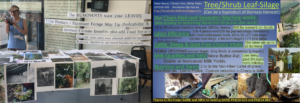
July 20th, 2024: Tree Canopy Harvests Rejuvenate Everyone! (trees, livestock, farmers, soil, Earth), Presentation & Workshop during the Permaculture & Agroforestry Convergence at MOFGA grounds (Unity, ME) drew 10 participants plus some part-time visits. I gave an over-view of forage use of trees including nutritional data and environmental benefits, and led discussion of applicability within participants’ settings. We then moved to trees I’d pollarded years before that were due for re-harvest, and I guided participants who completed all cuts and packing of a barrel of American Elm and Green Ash. Young people from an intentional community in MA are planning silvopastural use with livestock.
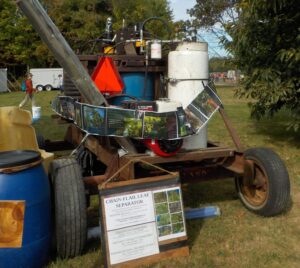
September 22-24, 2023: Common Ground Country Fair: My presentations were (a less leaf-silage, not very Project-related livestock talk x2, plus) Tree Fodder and Browse Q & A Circle (x3) which included much discussion of our harvest, plus leaf-silage samples, and Tree Silage! Leaf Separator Machine Demo (x1), which was well-received and was invited back a 2nd year. Participation in Project-related presentations was about 28. The machine was prominently on display and seen by thousands from the Northeast and beyond; Karl Hallen received a call from a NY colleague who saw it there.
Andres Velez had helped me harvest leaf-silage in July, and came to help me throughout the fair, which included us cutting a truckload of Sugar Maple the night before the Machine Demo. A farmer from out of State who had been to my Fair talks before, and had consulted by phone at a stressful point that summer when there was “no hay!”, reported significant successful harvest of dried branches of leaf-forage, with a secure winter ahead for their goat herd. He said the very long farm driveway needed trimming, and branches were easy to reach. We fit in a rope climbing lesson, so he now can reach even more.
September 20-22, 2024: Common Ground Country Fair: My presentations were Ruminants Eat Leaves! How Much? (& Why?) (x2), (partially?) recorded by a participant on my camera, Tree Fodder and Browse for Livestock Q & A (x2), and Leaf-Silage! Chain-Flail Leaf-Separator Demo, recorded professionally impromptu & edited by Bailey Riordan (see link below). Total participation for 5 timeslots was 35-40 (people come and go); the Fair drew 69,000 people mostly from the Northeastern US, and most of whom walked right by or looked at a visual display surrounding the Leaf-Separator. 2 participants stopped where my herd and I were camped for further consultation and safe rope-climbing instruction (always free).
(I also had in-depth discussions with 2-3 more folks at non-presentation times by the Leaf-Separator as I was finishing the load of brush, and post-Fair iI ncluded 3 young people who work on farms in 3 days of climbing harvest and leaf-separation of MOFGA Hybrid Willow.)
***See Ruminants eat Leaves! How much? (& Why?) video (& soon to be added Leaf-Silage! Chain-Flail Leaf-Separator Demo video) of 2024 Common Ground Fair presentations, above under “Information Products,” near top of this Report]
November 11th, 2024: Maine Forage Conference: Jaime Garzon asked if I had nutritional results (I sure do!), then invited me to be one of 5 farmer-panelists. I jam-packed 15 minutes with nutritional, toxin, Condensed Tannin, milk yield, harvest yield, and animal intake data, then fielded questions along with the other presenting farmers. The rest of that day I tabled with more leaf-forage info and samples, and talked with farmers and service providers about trees and leaves (some of us almost missed lunch – so fun to connect).
(*** “Forage Conference Slides with text added” which includes at end the “Forage Conference Handout” summary spreadsheet, are in the Annual Project Report for SARE FNE24-083, under “Informational Products.” *** )
2023 & ‘24 Harvest Field-days: In our proposal we had promised an on-farm demonstration event at Susan Littlefield’s Y Knot Farm. Susan ended up having too much happening, by the time we caught our breath from our belated harvest (starting with 2022 late machine arrival and then 2023 repairs). My farm as yet has no field edges with driving access, for such a Demo. I put out word of our activities (as planned), and offered flexibly-timed field-days by appointment. Seamus Blake (goat keeper from Virginia), Colin Yarnell (tiny farm in Searsmont plus our 3 Streams Farm), Matt Crisp (of Poor Proles Almanac; from Massachusetts, but was shepherding for Ararat Farms nearby me in Maine), Connor Breen (live-in relief goatherd/milking help for Jeanne Hergenrother of Grey Cameron (Ararat Farms & our Belfast Blueberry Cooperative) each came out at some point during leaf-harvest, to spend most of a day. These work visits/field days made harvest extra rewarding; thank you, all!
Both Ethan Andrews’ Free Press article (below, 7/11/2023 p. 3, which I instigated with a press release and follow-up phone call), and my own MOF & G article (2024June-Julyissue)which took many nonths of polishing with kind, discerning, and finely skilled editor Holli Cedarholm, recieved widespread readership, and each caused a few calls or emails from farmers.
"For the Munching of Aromatic Leaves," Innovations, Free Press article, July 11. 2023 Page 3
A Poor Proles’ Almamac podcast interview of me about tree/shrub forage aired during our project and triggered a small burst of farmer email exchanges (recorded just before our award; I described the proposal for this Project). Andy Cerone recorded a 2nd Poor Proles’ podcast interviewthis winter, toair this coming summer.
***Links to 1st Poor Prole’s Almanac interview of Shana Hanson, about tree/shrub forages (aired in 2 episodes):
Jaime Garson, UMaine Cooperative Extension (Waldo County) created a short Bulletin: Nutritive Value of Ensiled Leaves from Selected Maine Tree and Shrub Species for Forage Production,using my materials including an abbreviated table of my data (cited from the SARE FNE24-083 January 2025 Project Report, but as that project was a direct result of this one, I offer the draft here). He composed the Bulletin this winter as I wrote both Project Reports, andwanted to list me as co-author, but I was too occupied so asked to be simply credited. Jaime Garzon gave permission for inclusion of the draft, below:
Learning Outcomes
Farmers gained awareness that tree and shrub leaves can be packed as silage, and thatfield edges are a forage resource. They gained knowledge about usefulness of many species for various livestock, including potential intake rates, nutritional value, and safety/limitations/toxicities related to a minority of tree/shrub species. The farmers who participated in harvest field-days learned skills of pollarding trees, and learned to run our Leaf-Separator, and pack barrels.
Our machine supported an attitude-shift that temporate broadleaf tree/shrub forage harvesthas potential to become practical and worthwhile time-wise for modern farmers, versus being historically limited . We raised awareness that tree industries produce untapped forage resources, and that routine farm brush-clearing and ROW pruning can be forage harvests.
Awarenesses in particular that were raised: Concentrated energy in tree/shrub leaves as compared to grass forages may reduce grain cost (Jason Tessier, Tessier Farm); Leaf proteins that escape rumen fermentation may benefit cheese-making (Kaili Wardwell, Abraham’s Creamery); Cherry leaves have little risk of Hydrogen-Cyanide toxins when ensiled (many farmers, including email conversation); Box Elder leaves are dangerous to ruminants once fully mature; Potential exists for mechanical improvements that can make leaf-silage available in quantity, and tree/shrub-leaf forage value supports such development.
Project Outcomes
I expect increased animal health and higher winter milk yields, as I am committed to providing a significant winter quantity of summer-harvested tree/shrub leaf-silage to my animals from now on, in addition to daily fresh winter cutting of red maple which has been a substantial counterpart to hay here for many years, plus intermittent fresh winter cutting of Hemlock (and a bit of White Cedar, which used to be a winter staple, but is looking thin since the 2015-’18 droughts).
The animals are so excited on days when they see I’ve brought out a barrel! (When my aanimals are haappy, I’m happy!) So I am adding road access to our blueberry field and a tractor, to be able to use the Leaf-Separator on my own land (so far, harvests for the Leaf-Separator have entailed commuting to other people’s properties).
I have ongoing communication/consultation with 14 Maine farms where I have visited or will visit, to help them move toward more tree/shrub forage use. 2 of them were Trial Farms for FNE22-013, and have both increased their use. Also people from 2 out-of state farms caught me at the 2023 or ‘24 Fair for rope-climbing lessons; the first (as mentioned above) had put in significant dried leaf-forage when I saw him again in 2024 (no one but me has a Leaf-Separator yet, to make silage easily).
Assessment of approach (inc. successes and challenges): We set out to efficiently harvest leaf-dense tree/shrub silage, with less wood content than chipped leaf-silages, and then see how much our animals are willing to use. Labor-intensity of harvest-cutting remains a primary limitation, but our leaf-separating innovation duplicated laborious hand-stripping much more exactly and efficiently than expected, producing intact leaves relished by the animals. In writing our proposal, I overestimated how much leaf-silage would fit in the barrels (intact leaves take more space than the shredded leaves I was expecting), and underestimated the animals eagerness to consume (the very low quality of 2023 grass hay raised importance of nutrition in our leaf-silage). Our approach was right on mark, but our methods included more trials than we could fully supply, at enthusiastic ruminant rates of intake. So we modified trials, to learn as much as possible from the amount of leaf-silage we were able to produce.
Field edge harvest was ideal, for driveable access and machine placement. But our largest site, MOFGA South Parking, was too far from home to commute, so I had planned to bring the herd and stay during harvest. I was not expecting such frequent rain as we had in that 2023 summer. Snails everywhere, and deer, meant too much danger of Meningial worm for goats, so I commuted after all. This caused short days of work = many more commutes, because I had to wander the woodlands with animals at home, first each day (at MOFGA, I could have rotated them on more grass than I have at home, plus easily thrown them loads of leafy brush). I also had trouble finding steady intern help.
So this harvest design was costly and impractical for me, but useful as imitation of other people’s farm settings, with larger fields than I have myself. And with persistence I filled all the barrels!
Further harvest development: I would like to see application of our findings to silvopastural and alley-crop tree plantings, which are now encouraged as Climate-Smart practices. Such multiplication of field-edge lineal feet will provide a great volume of leaf-silage, and pollarding (canopy harvest) bestows root-cycling benefits of drought and waterlogging resilience to soil. Rydgren, Austad, Hanre and Topper (2020) have studied yield benefit of pollard harvest in a traditional Norwegian wooded hay meadow; Northeastern US trials are in order.
Such rows of planted trees are well-suited to trial mechanical forage harvests. Small long-armed feller-bunchers are already in use for European biomass harvest from pollards. That machine can feed our Leaf-Separator, with a chipper placed or attached to receive outflow. Alternatively, trees can be treated as square Topiary and cut with a hedge-trimming machine, which collects prunings (these short young prunings can be triled as forage without leaf-separation). Karl Hallen says collection from various other large pruning machines is “a simple materials handling issue” (phone conversation, 2/19/25).
Karl wants to pursue post-chipping leaf-separation himself, at some point. This would expand his SUNY ESF Willow Biomass Project harvests into the leaf season, while providing leaf-silage to livestock trials which I would organize. Such mechanical development would be applicable to leaf-silage production within many industrial settings. Resulting leaf-products would be shredded versus intact; Juan Romero, PhD,Animal Science professor and forage researcher, UMaine, told me (at a UMaine Extension silage event last winter) that faster leaf fermentation from shredding would be beneficial (certainly helpful if bunker-ensiling; less necessary in our tight barrels).
Methods, challenges and changes: My home 3 Streams Farm trial was the longest and most well-supplied, since obtaining milk yield differences was a priority. But even with expert livestock research consultation from Juan Alvez, we failed to consider day-length until I saw UMaine (very part-time) intern Megan Smith’s graphs showing our seasonal rise in milk production. Exclusion of the 1st leaf-silage period from my leaf-silage versus 2nd-cut hay milk-yield comparison corrected that confounding factor.
My Jersey cow (mother of steer Angelo) sadly died in July 2022, and I was lucky to find John Morse willing to replace that milking trial, using their mini-Jersey cow. His trial was much shorter than my original home trial plan, but his grain-fed data with a cow in winter stanchion gave a helpful look at (very positive) leaf-silage milk yield effects on a very different farm than mine.
Further laboratory research: Wayne Zeller, USDA ARS, will continue to break ground on C Tannin ID using this Project’s plus FNE24-083 leaf-samples, so long as our Federal government does not place “on hold” or close his laboratory. Research of digestive impacts can follow; the same lab (US Dairy Forage Research Center, Madison WI) has cattle, and In Vitro capability. Northeastern ruminant farmers do not all succeed at growing Birdsfoot Trefoil, the go-to CT source, for their herds, but all have trees and shrubs on their farms.
CT effects on ruminent protein utilization and methane emissions are hot topics currently. Once CT ID is complete, Wayne hopes to test effects of my still-plentiful frozen leaf-silage samples on in-vitro methane production.
I have barely found vitamin research on Northeastern tree/shrub leaves. Vitamins in ruminant nutrition are not yet a hot topic, but my steer is right now having a worrisome mid-winter lull in appetite, which did not happen last winter when abundant leaf-silage was fed. He does not strip as much maple bark as the goats (they are having no such lull), but when let out seeks vitamin-rich White Cedar (in short supply with reduced growth ever since 5 droughts in 6 years, 2015-2020). Likewise vitamins for humans in the milk may be of interest.
Volatile Organic Compounds (VOCs) in leaves also have probable benefits, to be further explored for effects on livestock, humans, and milk shelf-life.
Andrea Clemensen’s USDA ARS effort to solicit lipid ID in leaf-silage fed during my 3 Streams Farm trial, (and possibly relate by date fed to Yulica Santos Ortega’s lipid ID in the milk thus produced) is, like Wayne’s work, vulnerable to Federal mandates. Lipid profiling has been done on European leaf species, but so far as I know has not been done on Northeastern US leaves. Research of digestive impacts should follow that as well; I speculate about relation of the shiny Gray Birch leaf coating to seasonal refusals.
Yulica Santos Ortega identified hundreds of lipids in our goats’ milk with and without leaf-silage fed. It would be helpful to find a Food Science person to relate human health data to these milk lipid profiles. Anti-oxidant value in our milk, from leaves fed, is likewise of interest and as yet unexplored.
Benefits of such research affect farmers. Health care is priced much higher than milk (and even higher than meat). Human health benefits already raise value and sales of grass-fed products, and may do so further when health effects become known from feeding leafy browse. Mechanical on-farm harvest methods above, and/or industrial developments to process leaves already being harvested in timber, biomass and arborist industries, also described above, can simultaneously reduce farmers’ leaf-harvest labor, for the economics to meet. Viability of routine leaf-silage use on farms can thus go beyond our Climate-Smart forage solution aimed at weather-related forage crises.
Further on-farm research: On my farm, I need to understand Gray Birch seasonal edibility, because I have large quantities of young growth to cut, as do other blueberry growers (blueberry field “weed”). Researchers are unlikely to jump onto this, but my animals can effectively analyse at various dates for me, if I make a point to travel there for sampling. Box Elder toxicity is more critical, but will take collaboration for more distant sampling; I’m hoping my herd will test that also, this coming summer.
This summer I will also re-sample for commitments of SARE FNE24-083 to more thoroughly test H Cyanide in Black Cherry leaves, wilted and with various lengths of ensilement. I am re-doing these samples because Ziploc bag ensiling containment failed (the samples molded from air entry, I think due to a change in bag design).
The next summer, I hope to pick up my intermittant leaf-harvest collaboration with Art Batson and Lucas Tree, to upscale leaf-silage production for my own farm. I will at first bring intact brush home to the Leaf-Separtor, but eventually I hope to get the current funky Leaf-Separator re-mounted onto a road-worthy trailer. Beyond chasing Lucas Tree harvests, I want to get it down the road smoothly for farm-sharing (vs limited to 15 mi/hr) - and find a farmer more techy than me to set it up with farm-rigged leaf-silage containment (baling). Dave Flood (who made the 2nd-cut hay for my 3 Streams Farm Trial) has donated a square baler which we are allowed to disassemble or modify; Karl found a YouTube video showing successful square-baling of tree leaves (for compost though, not fodder).
This work will preceed next efforts to fund an improved (possibly compact multifunctional) roadworthy iLeaf-Separator, to further upscale supply for other farms.
Other farms need that greater leaf-silage supply for ration-testing for effects on productivity. Now that our nutritional data is in (including that of FNE24-083), such rations can be planned.
Why I continue: I am addicted tp the aromatic tree/shrub compounds which collect, to delight all present when we open a barrel. My animals are similarly euphoric when thus supplied, and their happiness within our relationship sustains me (happiness = milk). (Plus I am very at-home up in trees, and I care about my CSA milk-drinkers, who come out of their way for leafy milk.) So I will always be pursuing tree matter for my animals.
The Chain-Flail Leaf-Separator makes this all more doable, though I must (and will) cut a road at my separate wild blueberry property in order to use it on-farm.
Beyond my own animals and happiness, I am strongly driven by concern about planetary leaf-surface decrease and resulting climate disregulation. So I will always be pursuing knowledge to encourage other farmers to create and use leafier farm-scapes. Doing so formally in this Project, and especially with our very encouraging animal intake and milk results, has immensely strengthened such efforts toward sustainable farm ecosystems.
Who can benefit? Grass-fed ruminant farmers (such as myself), and all goat farmers , can especially benefit from our information and progress on tree/shrub use, especially when climate challenges reduce quantity or quality of grass harvests. Northeastern farms will find our regionally-produced data to be most pertinent to their specific farm resources, but methods and new machine are applicable anywhere. (Zoos can strongly benefit from our machine development, as many are hand-stripping leaf-silage – but they are not within my committed outreach).
Mid-sized and large farms need more machine-harvest development to access and use leaf-silage. Small Northeastern farms, including most Maine goat and sheep farms, are already able to use our information to beneficially ration leaf-forages.
Citation:
Rydgren, Knut, Ingvild Austad, Liv Norunn Hamre,& Joachim P. Töpper (2020). Wooded hay meadows as viable production systems in sustainable small-scale farming. Copyright Springer Nature, published online: 28 November 2020. Also, Agroforest Syst (2021) 95:165–176.
Information Products
- 1. Livestock want Browse: Doable Methods for Use of Wild Woody Perennials
- 2. Livestock want Browse hand-out, NOFA NH Feb 11, 2023
- 4. Tree & Shrub Leaf-Silage Production for Agroforestry Systems
- 5. Ruminants Eat Leaves! How Much? (& Why?), Live Presentation Video, Common Ground Fair Sept 21, 2024
- 6. Tree and Shrub Leaf-Silage Production for Agroforestry Systems, Webinar Recording of NOFA MA "Go Nuts" Discussion Series, May 2, 2024
- 3. Tree & Shrub Leaf-Silage Production for Agroforestry Systems, Presentation for NOFA MA, May 2, 2024 with text added
- Efficient Leaf-dense Tree/Shrub Silage Production from Field Edges: Climate-Resilient Forage Supplement for Cattle, Sheep, and Goats: Final report with Table of Contents
